我们通常聊到spring bean的生命周期,大多是从网上找帖子背些基本概念,这样我们学到的东西是不够直观清晰的,这篇文章我就试着从源码级别来讲清楚bean的创建过程。
一、准备demo代码
我们既然要深入源码来看bean的创建过程,那么就要写一个简单的demo,用于我们debug跟踪代码的执行过程,从而可以非常直观的看到核心源码发挥的作用。
java
package com.example.bean;
import org.springframework.context.annotation.AnnotationConfigApplicationContext;
public class Test1 {
public static void main(String[] args) {
AnnotationConfigApplicationContext context = new AnnotationConfigApplicationContext(AppConfig.class);
Student student1 = (Student)context.getBean("student");
Student student2 = (Student)context.getBean("student");
System.out.println(student1 == student2);
}
}可以看到里面涉及到了Student类,Student类代码如下:
java
package com.example.bean;
import org.springframework.beans.factory.InitializingBean;
import org.springframework.beans.factory.annotation.Autowired;
import org.springframework.stereotype.Component;
@Component
public class Student implements InitializingBean {
@Autowired
private Cource cource;
private String name;
private Integer age;
public String getName() {
return name;
}
public void setName(String name) {
this.name = name;
}
public Integer getAge() {
return age;
}
public void setAge(Integer age) {
this.age = age;
}
@Override
public void afterPropertiesSet() throws Exception {
this.name = "zhangsan";
this.age = 10;
}
}在学生类中还注入了课程类Cource,这个类代码如下:
java
package com.example.bean;
import org.springframework.beans.factory.InitializingBean;
import org.springframework.stereotype.Component;
@Component
public class Cource implements InitializingBean {
private String courceName;
public String getCourceName() {
return courceName;
}
public void setCourceName(String courceName) {
this.courceName = courceName;
}
@Override
public void afterPropertiesSet() throws Exception {
this.courceName = "语文";
}
}除了这两个我们要重点关注的类之外,我们还要关注AppConfig类,这个类用于指定我们扫描包的范围,是非常重要的。
java
package com.example.bean;
import org.springframework.context.annotation.ComponentScan;
import org.springframework.context.annotation.Configuration;
@Configuration
@ComponentScan("com.example.bean")
public class AppConfig {
}我们整体代码的结构如下图所示。
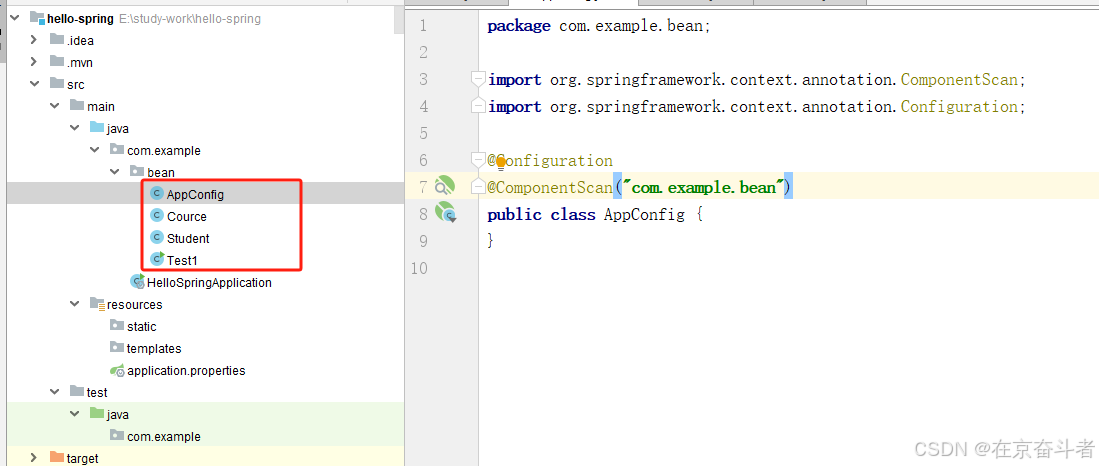
上面在Test1这个类中我们使用的AnnotationConfigApplicationContext 是 Spring 框架中用于基于注解配置的应用程序上下文实现类。如果你程序还是用xml来定义bean的话,就得用ClassPathXmlApplicationContext这个上下文实现类了。
二、准备注解解析器和组件扫描器
我们看代码new AnnotationConfigApplicationContext(AppConfig.class);点击进去看里面的源码,如下所示。
可以看到入参是不固定数量的,不过从形参名称componentClasses就可以看出来入参跟Component相关,而我们的入参类AppConfig类上就有@ComponentScan注解,这个注解用于扫描指定包下的类。
java
/**
* Create a new AnnotationConfigApplicationContext, deriving bean definitions
* from the given component classes and automatically refreshing the context.
* @param componentClasses one or more component classes — for example,
* {@link Configuration @Configuration} classes
*/
public AnnotationConfigApplicationContext(Class <? > ...componentClasses) {
this();
register(componentClasses);
refresh();
}接下来我们看构造方法的第一行代码this();显然这是调用了内部的无参构造器,我们看看这个无参构造器中都有哪些代码,如下所示。
其中StartupStep createAnnotatedBeanDefReader = this.getApplicationStartup().start("spring.context.annotated-bean-reader.create");这行代码只是启动一个性能监控步骤,用于记录创建AnnotatedBeanDefinitionReader的耗时,它不是重点,这个我们直接忽略它。2.1 注解解析器
接下来就是this.reader = new AnnotatedBeanDefinitionReader(this);这是准备注解解析器的代码,我们点进去看看里面的逻辑。
java
/**
* Create a new AnnotationConfigApplicationContext that needs to be populated
* through {@link #register} calls and then manually {@linkplain #refresh refreshed}.
*/
public AnnotationConfigApplicationContext() {
StartupStep createAnnotatedBeanDefReader = this.getApplicationStartup().start("spring.context.annotated-bean-reader.create");
this.reader = new AnnotatedBeanDefinitionReader(this);
createAnnotatedBeanDefReader.end();
this.scanner = new ClassPathBeanDefinitionScanner(this);
}可以看到如下图所示内容,可以看到我们把AnnotationConfigApplicationContext作为BeanDefinitionRegistry类型的入参传进来了,然后内部调用到registerAnnotationConfigProcessors(BeanDefinitionRegistry registry)方法的调用链如下图所示,这些代码不是重点,我们知道是这么个调用流程即可。
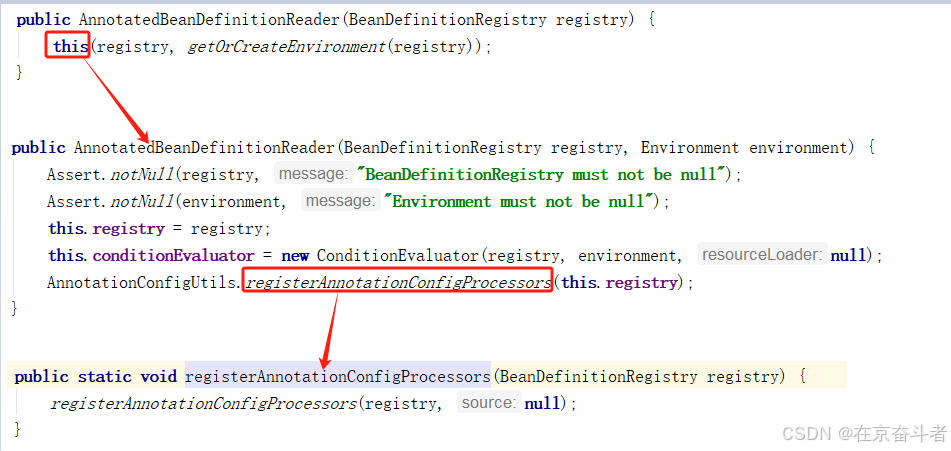
之所以把AnnotationConfigApplicationContext作为参数可以直接作为AnnotatedBeanDefinitionReader(BeanDefinitionRegistry registry)的参数传过来是因为AnnotationConfigApplicationContext是BeanDefinitionRegistry的实现类,如下图所示。
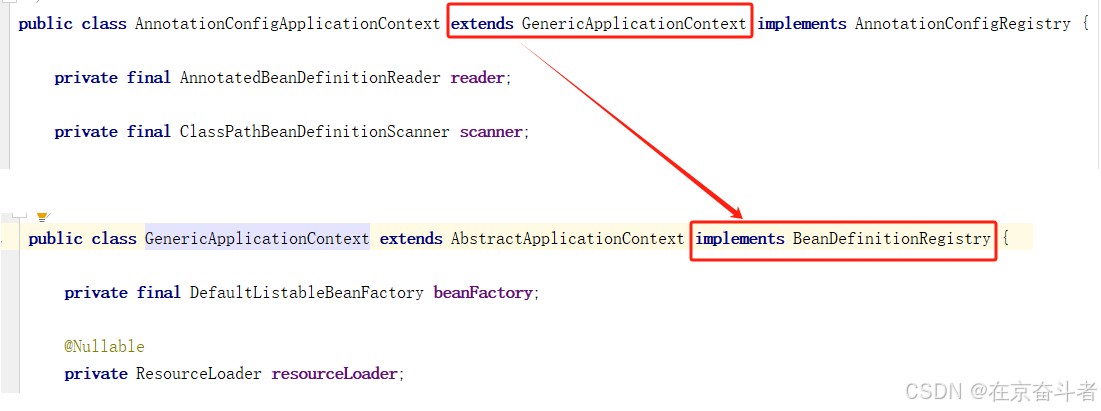
我们接着回到上面提到的registerAnnotationConfigProcessors(BeanDefinitionRegistry registry)方法,如下所示,我们关注里面的registerAnnotationConfigProcessors(registry, null);方法。
java
public static void registerAnnotationConfigProcessors(BeanDefinitionRegistry registry) {
registerAnnotationConfigProcessors(registry, null);
}方法源码如下,这里面上来就看到一个非常核心的组件DefaultListableBeanFactory,这个组件有多核心,我们总结一下这个组件的功能就知道了。
java
public static Set < BeanDefinitionHolder > registerAnnotationConfigProcessors(
BeanDefinitionRegistry registry, @Nullable Object source) {
DefaultListableBeanFactory beanFactory = unwrapDefaultListableBeanFactory(registry);
if (beanFactory != null) {
if (!(beanFactory.getDependencyComparator() instanceof AnnotationAwareOrderComparator)) {
beanFactory.setDependencyComparator(AnnotationAwareOrderComparator.INSTANCE);
}
if (!(beanFactory.getAutowireCandidateResolver() instanceof ContextAnnotationAutowireCandidateResolver)) {
beanFactory.setAutowireCandidateResolver(new ContextAnnotationAutowireCandidateResolver());
}
}
//......这里暂时省略一部分代码
}DefaultListableBeanFactory说明如下:
DefaultListableBeanFactory是spring框架中最核心的BeanFactory实现类,负责管理bean的定义、实例化、依赖注入以及生命周期,它是Spring IoC容器的基础设施,同时也是高级容器(如ApplicationContext)的底层实现。好家伙,这一个组件就包括了这么多功能,下面具体说下每个功能。
1)Bean定义管理
实现了BeanDefinitionRegistry接口,支持动态注册和存储Bean定义(BeanDefinition)。
另一个就是维护了一个Map<String, BeanDefinition>结构的beanDefinitionMap,这个map用来存储所有bean的基础信息(BeanDefinition在创建bean时使用)。

2)Bean实例化与依赖注入
继承AbstractAutowireCapableBeanFactory,提供bean的实例化、属性填充(populateBean)和初始化(initializeBean)逻辑。
支持构造器注入和Setter注入。

3)单例与作用域管理
维护单例bean缓存(singletonObjects),支持singleton和prototype作用域。
通过三级缓存(第三级singletonFactories、第二级earlySingletonObjects、第一级singletonObjects)解决循环依赖问题。
4)类型转换与自动装配
实现AutowireCapableBeanFactory,支持按类型(byType)或名称(byName)自动装配。
处理@Autowired、@Value、@Resource等注解的依赖注入。
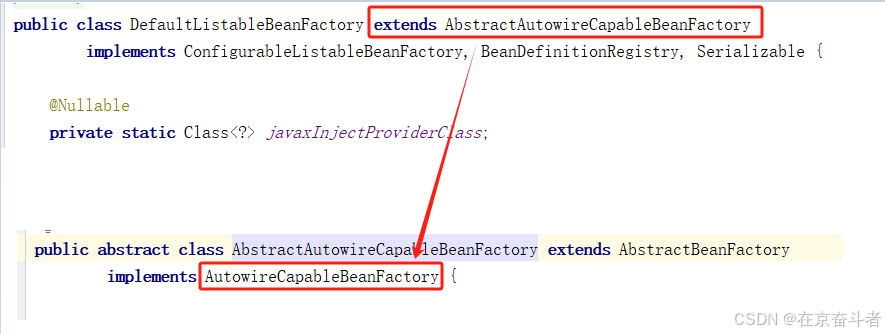
5)生命周期回调
处理InitializingBean、DisposableBean 等接口的回调。
支持@PostConstruct 和@PreDestroy 注解。
6)Bean后置处理
通过BeanPostProcessor和BeanFactoryPostProcessor扩展bean的创建和初始化逻辑。
说完DefaultListableBeanFactory,我们再回到刚才registerAnnotationConfigProcessors方法的源码,如下所示。我们第一步获取到DefaultListableBeanFactory之后,便接着给这个beanFactory设置dependencyComparator和autowireCandidateResolver这两个组件。
java
public static Set < BeanDefinitionHolder > registerAnnotationConfigProcessors(
BeanDefinitionRegistry registry, @Nullable Object source) {
DefaultListableBeanFactory beanFactory = unwrapDefaultListableBeanFactory(registry);
if (beanFactory != null) {
if (!(beanFactory.getDependencyComparator() instanceof AnnotationAwareOrderComparator)) {
beanFactory.setDependencyComparator(AnnotationAwareOrderComparator.INSTANCE);
}
if (!(beanFactory.getAutowireCandidateResolver() instanceof ContextAnnotationAutowireCandidateResolver)) {
beanFactory.setAutowireCandidateResolver(new ContextAnnotationAutowireCandidateResolver());
}
}
//......这里暂时省略一部分代码
}其中beanFactory.setDependencyComparator(AnnotationAwareOrderComparator.INSTANCE);这句代码是要配置依赖比较器,确保BeanFactory使用AnnotationAwareOrderComparator作为依赖比较器,它的作用是在自动装配时,spring需要确定多个候选bean的注入顺序,这时AnnotationAwareOrderComparator可以解析@Order或者@Priority注解以及Ordered接口按优先级排序bean。
其次就是beanFactory.setAutowireCandidateResolver(new ContextAnnotationAutowireCandidateResolver());这句代码是配置自动装配候选解析器。它的作用是在自动装配过程中决定哪些bean符合条件作为候选依赖。注解支持@Qualifier(按名称精确匹配 Bean)、@Value(解析 SpEL 表达式或占位符)、@Lazy(延迟初始化代理)。
接下来我们继续分析registerAnnotationConfigProcessors方法的源码如下所示,可以看到是要组装beanDefs,这是个由BeanDefinitionHolder组成的Set集合。然后看到下面很多if判断并且往这个beanDefs里面添加元素,我们就拿第一个if判断来举例。
java
public static Set < BeanDefinitionHolder > registerAnnotationConfigProcessors(
BeanDefinitionRegistry registry, @Nullable Object source) {
//......这里暂时省略一部分代码
Set < BeanDefinitionHolder > beanDefs = new LinkedHashSet < > (8);
if (!registry.containsBeanDefinition(CONFIGURATION_ANNOTATION_PROCESSOR_BEAN_NAME)) {
RootBeanDefinition def = new RootBeanDefinition(ConfigurationClassPostProcessor.class);
def.setSource(source);
beanDefs.add(registerPostProcessor(registry, def, CONFIGURATION_ANNOTATION_PROCESSOR_BEAN_NAME));
}
if (!registry.containsBeanDefinition(AUTOWIRED_ANNOTATION_PROCESSOR_BEAN_NAME)) {
RootBeanDefinition def = new RootBeanDefinition(AutowiredAnnotationBeanPostProcessor.class);
def.setSource(source);
beanDefs.add(registerPostProcessor(registry, def, AUTOWIRED_ANNOTATION_PROCESSOR_BEAN_NAME));
}
// Check for JSR-250 support, and if present add the CommonAnnotationBeanPostProcessor.
if (jsr250Present && !registry.containsBeanDefinition(COMMON_ANNOTATION_PROCESSOR_BEAN_NAME)) {
RootBeanDefinition def = new RootBeanDefinition(CommonAnnotationBeanPostProcessor.class);
def.setSource(source);
beanDefs.add(registerPostProcessor(registry, def, COMMON_ANNOTATION_PROCESSOR_BEAN_NAME));
}
// Check for JPA support, and if present add the PersistenceAnnotationBeanPostProcessor.
if (jpaPresent && !registry.containsBeanDefinition(PERSISTENCE_ANNOTATION_PROCESSOR_BEAN_NAME)) {
RootBeanDefinition def = new RootBeanDefinition();
try {
def.setBeanClass(ClassUtils.forName(PERSISTENCE_ANNOTATION_PROCESSOR_CLASS_NAME,
AnnotationConfigUtils.class.getClassLoader()));
} catch (ClassNotFoundException ex) {
throw new IllegalStateException(
"Cannot load optional framework class: " + PERSISTENCE_ANNOTATION_PROCESSOR_CLASS_NAME, ex);
}
def.setSource(source);
beanDefs.add(registerPostProcessor(registry, def, PERSISTENCE_ANNOTATION_PROCESSOR_BEAN_NAME));
}
if (!registry.containsBeanDefinition(EVENT_LISTENER_PROCESSOR_BEAN_NAME)) {
RootBeanDefinition def = new RootBeanDefinition(EventListenerMethodProcessor.class);
def.setSource(source);
beanDefs.add(registerPostProcessor(registry, def, EVENT_LISTENER_PROCESSOR_BEAN_NAME));
}
if (!registry.containsBeanDefinition(EVENT_LISTENER_FACTORY_BEAN_NAME)) {
RootBeanDefinition def = new RootBeanDefinition(DefaultEventListenerFactory.class);
def.setSource(source);
beanDefs.add(registerPostProcessor(registry, def, EVENT_LISTENER_FACTORY_BEAN_NAME));
}
return beanDefs;
}第一个If判断如下,上来先判断在注册器registry中是否有常量CONFIGURATION_ANNOTATION_PROCESSOR_BEAN_NAME,这个常量我们在当前AnnotationConfigUtils这个类中可以看到如下图所示,是一个挺长名字的字符串。
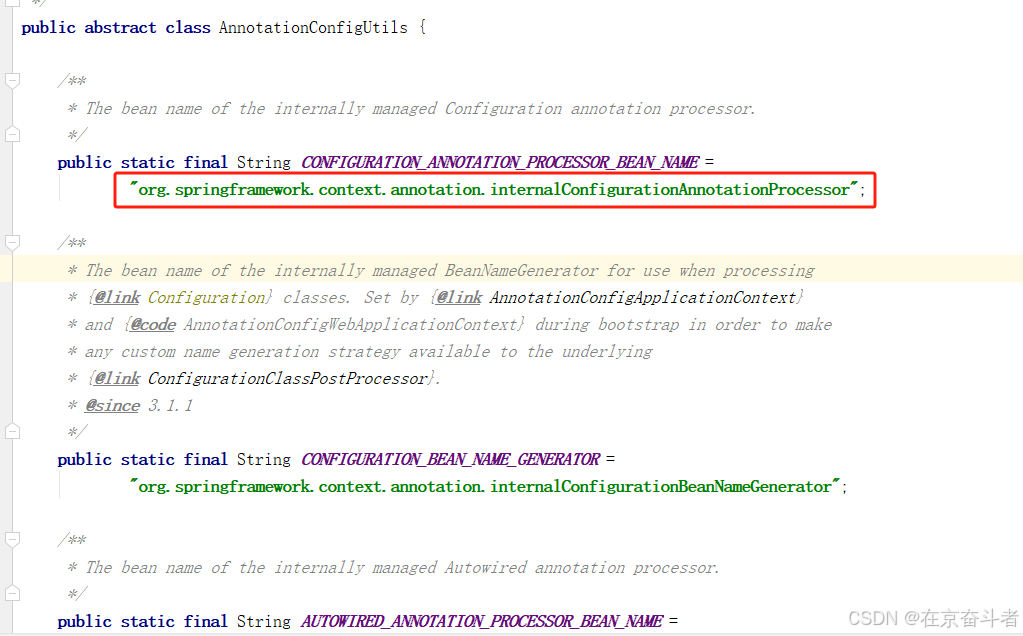
java
if (!registry.containsBeanDefinition(CONFIGURATION_ANNOTATION_PROCESSOR_BEAN_NAME)) {
RootBeanDefinition def = new RootBeanDefinition(ConfigurationClassPostProcessor.class);
def.setSource(source);
beanDefs.add(registerPostProcessor(registry, def, CONFIGURATION_ANNOTATION_PROCESSOR_BEAN_NAME));
}我们看registry.containsBeanDefinition方法内部逻辑,可以看到有三个实现类,我们刚从上面知道我们使用工厂是DefaultListableBeanFactory,因此我们进入到DefaultListableBeanFactory这个内部看看

方法registry.containsBeanDefinition具体代码如下,可以看到就是判断beanDefinitionMap中是否存在当前key。由于我们目前还处于最开始阶段,因此这里beanDefinitionMap是空,也就是key在map中不存在。
java
@Override
public boolean containsBeanDefinition(String beanName) {
Assert.notNull(beanName, "Bean name must not be null");
return this.beanDefinitionMap.containsKey(beanName);
}beanDefinitionMap的定义如下。
java
/** Map of bean definition objects, keyed by bean name. */
private final Map<String, BeanDefinition> beanDefinitionMap = new ConcurrentHashMap<>(256);因此就进入到if内部,如下所示,可以看到定义了一个根beanDefinition,也就是RootBeanDefinition,它是由ConfigurationClassPostProcessor真正来实现具体功能的。ConfigurationClassPostProcessor是spring实现注解驱动编程(如@Configuration、@Bean、@ComponentScan等)的关键组件。负责解析和处理基于注解的配置元数据。
java
if (!registry.containsBeanDefinition(CONFIGURATION_ANNOTATION_PROCESSOR_BEAN_NAME)) {
RootBeanDefinition def = new RootBeanDefinition(ConfigurationClassPostProcessor.class);
def.setSource(source);
beanDefs.add(registerPostProcessor(registry, def, CONFIGURATION_ANNOTATION_PROCESSOR_BEAN_NAME));
}然后我们进入到beanDefs.add()方法中调用的方法registerPostProcessor,看看里面做了什么操作。这里面我们重点关注registry.registerBeanDefinition(beanName, definition);这行代码
java
private static BeanDefinitionHolder registerPostProcessor(
BeanDefinitionRegistry registry, RootBeanDefinition definition, String beanName) {
definition.setRole(BeanDefinition.ROLE_INFRASTRUCTURE);
registry.registerBeanDefinition(beanName, definition);
return new BeanDefinitionHolder(definition, beanName);
}DefaultListableBeanFactory工厂类中registerBeanDefinition方法源码如下所示,我们目前beanDefinitionMap中还没有元素,因此existingDefinition是null,因此走else分支代码,else分支代码中上来是判断目前是不是正在创建bean,代码:if (hasBeanCreationStarted())
java
@Override
public void registerBeanDefinition(String beanName, BeanDefinition beanDefinition)
throws BeanDefinitionStoreException {
Assert.hasText(beanName, "Bean name must not be empty");
Assert.notNull(beanDefinition, "BeanDefinition must not be null");
if (beanDefinition instanceof AbstractBeanDefinition) {
try {
((AbstractBeanDefinition) beanDefinition).validate();
} catch (BeanDefinitionValidationException ex) {
throw new BeanDefinitionStoreException(beanDefinition.getResourceDescription(), beanName,
"Validation of bean definition failed", ex);
}
}
BeanDefinition existingDefinition = this.beanDefinitionMap.get(beanName);
if (existingDefinition != null) {
if (!isAllowBeanDefinitionOverriding()) {
throw new BeanDefinitionOverrideException(beanName, beanDefinition, existingDefinition);
} else if (existingDefinition.getRole() < beanDefinition.getRole()) {
// e.g. was ROLE_APPLICATION, now overriding with ROLE_SUPPORT or ROLE_INFRASTRUCTURE
if (logger.isInfoEnabled()) {
logger.info("Overriding user-defined bean definition for bean '" + beanName +
"' with a framework-generated bean definition: replacing [" +
existingDefinition + "] with [" + beanDefinition + "]");
}
} else if (!beanDefinition.equals(existingDefinition)) {
if (logger.isDebugEnabled()) {
logger.debug("Overriding bean definition for bean '" + beanName +
"' with a different definition: replacing [" + existingDefinition +
"] with [" + beanDefinition + "]");
}
} else {
if (logger.isTraceEnabled()) {
logger.trace("Overriding bean definition for bean '" + beanName +
"' with an equivalent definition: replacing [" + existingDefinition +
"] with [" + beanDefinition + "]");
}
}
this.beanDefinitionMap.put(beanName, beanDefinition);
} else {
if (hasBeanCreationStarted()) {
// Cannot modify startup-time collection elements anymore (for stable iteration)
synchronized(this.beanDefinitionMap) {
this.beanDefinitionMap.put(beanName, beanDefinition);
List < String > updatedDefinitions = new ArrayList < > (this.beanDefinitionNames.size() + 1);
updatedDefinitions.addAll(this.beanDefinitionNames);
updatedDefinitions.add(beanName);
this.beanDefinitionNames = updatedDefinitions;
removeManualSingletonName(beanName);
}
} else {
// Still in startup registration phase
this.beanDefinitionMap.put(beanName, beanDefinition);
this.beanDefinitionNames.add(beanName);
removeManualSingletonName(beanName);
}
this.frozenBeanDefinitionNames = null;
}
if (existingDefinition != null || containsSingleton(beanName)) {
resetBeanDefinition(beanName);
} else if (isConfigurationFrozen()) {
clearByTypeCache();
}
}hasBeanCreationStarted方法内部代码如下,其实就是判断了一个名叫alreadyCreated的集合是否有元素,在这个阶段这个集合还没有开始创建bean,这里集合是空的,因此返回的是false。
java
/**
* Check whether this factory's bean creation phase already started,
* i.e. whether any bean has been marked as created in the meantime.
* @since 4.2.2
* @see #markBeanAsCreated
*/
protected boolean hasBeanCreationStarted() {
return !this.alreadyCreated.isEmpty();
}回过来上面的registerBeanDefinition方法代码就会走到如下图所示位置,这里就是将beanName作为key,将beanDefinition作为value保存到了beanDefinitionMap当中,并且把beanName也专门保存到beanDefinitionNames集合当中。
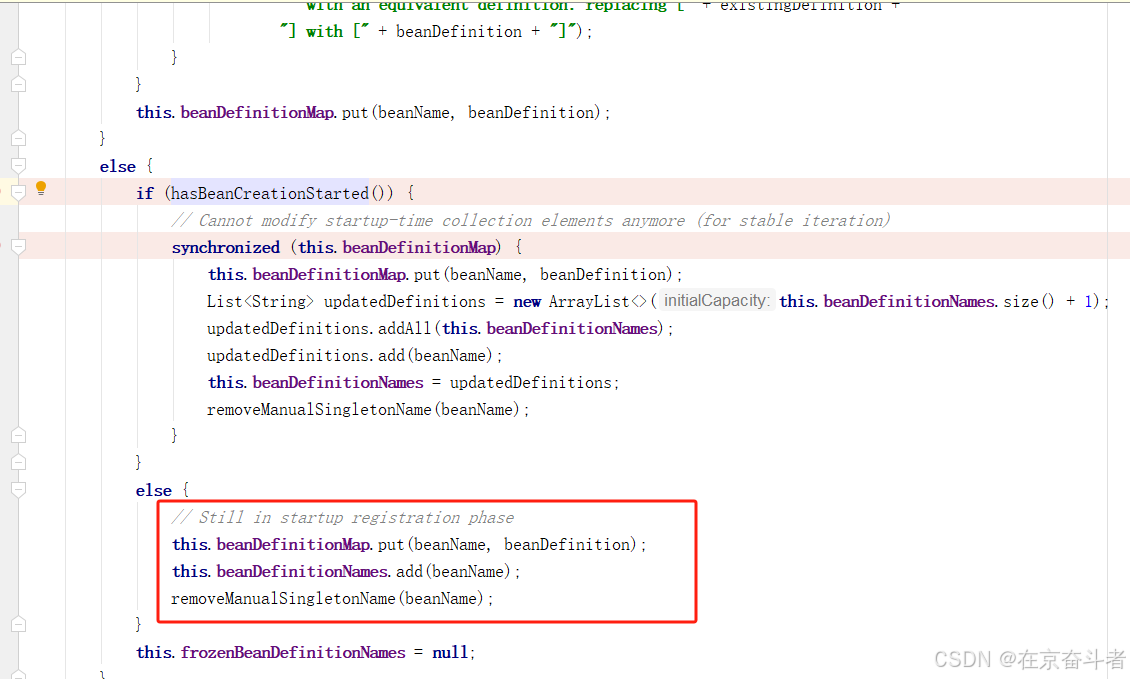
我们再回到上面提到的registerAnnotationConfigProcessors方法,我们刚才只是举例说明了第一个if条件判断中的逻辑。另外还要简单提一下的是beanName为下面二个
java
/**
* The bean name of the internally managed Autowired annotation processor.
*/
public static final String AUTOWIRED_ANNOTATION_PROCESSOR_BEAN_NAME =
"org.springframework.context.annotation.internalAutowiredAnnotationProcessor";
/**
* The bean name of the internally managed JSR-250 annotation processor.
*/
public static final String COMMON_ANNOTATION_PROCESSOR_BEAN_NAME =
"org.springframework.context.annotation.internalCommonAnnotationProcessor";其中org.springframework.context.annotation.internalAutowiredAnnotationProcessor这个beanName对应的根beanDefinition是AutowiredAnnotationBeanPostProcessor,它是spring依赖注入机制的关键组件,负责处理@Autowired、@Value、@Inject等注解,完成bean的自动装配逻辑。
另外org.springframework.context.annotation.internalCommonAnnotationProcessor这个beanName对应的根beanDefinition是CommonAnnotationBeanPostProcessor,它是BeanPostProcessor的实现类,主要功能包括:
1)处理生命周期注解
@PostConstruct:在bean初始化阶段,(afterPropertiesSet 之后、init-method 之前)调用标记的方法。
@PreDestroy:在bean销毁阶段调用标记的方法。
2)处理依赖注入注解
@Resource:按名称或类型注入依赖,支持JNDI查找(需配置)。
2.2 组件扫描器
我们再回到AnnotationConfigApplicationContext无参构造器源码这块,我们下面接着分析this.scanner = new ClassPathBeanDefinitionScanner(this);这行代码
java
public AnnotationConfigApplicationContext() {
StartupStep createAnnotatedBeanDefReader = this.getApplicationStartup().start("spring.context.annotated-bean-reader.create");
this.reader = new AnnotatedBeanDefinitionReader(this);
createAnnotatedBeanDefReader.end();
this.scanner = new ClassPathBeanDefinitionScanner(this);
}嵌套比较深,调用链如下,我们重点关注下面setResourceLoader(resourceLoader);方法。
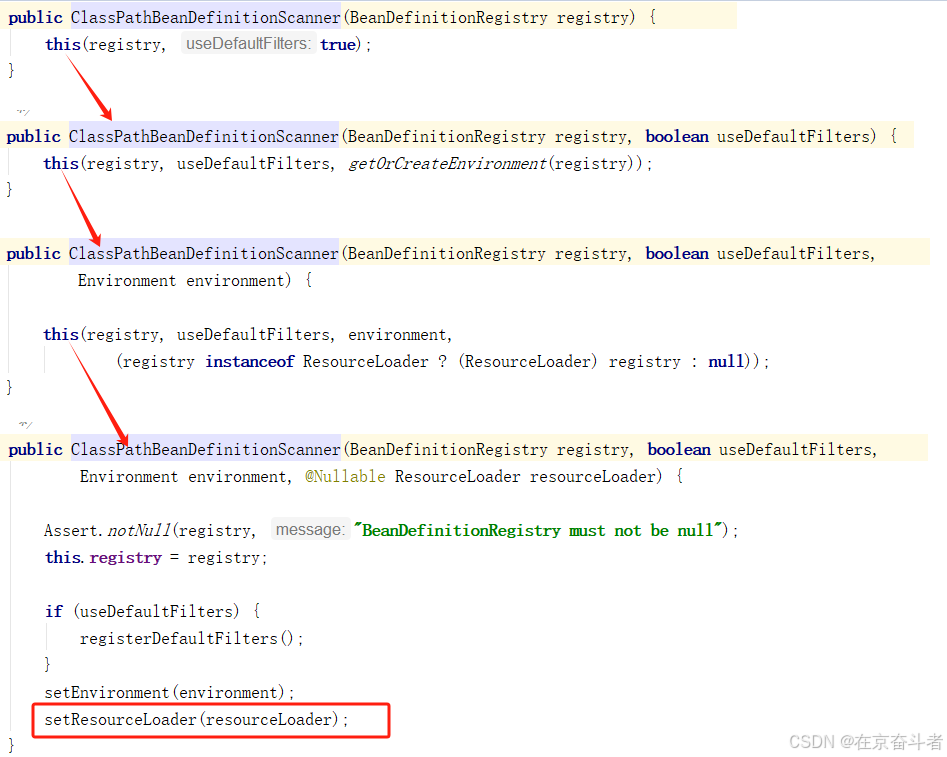
方法setResourceLoader内容源码如下,该方法用于配置与资源加载相关的核心组件,支持类路径扫描和组件索引加载,常用于spring的组件扫描器(如ClassPathBeanDefinitionScanner)或元数据处理类中。
java
public void setResourceLoader(@Nullable ResourceLoader resourceLoader) {
this.resourcePatternResolver = ResourcePatternUtils.getResourcePatternResolver(resourceLoader);
this.metadataReaderFactory = new CachingMetadataReaderFactory(resourceLoader);
this.componentsIndex = CandidateComponentsIndexLoader.loadIndex(this.resourcePatternResolver.getClassLoader());
}1)初始化资源模式解析器
this.resourcePatternResolver = ResourcePatternUtils.getResourcePatternResolver(resourceLoader);是将ResourceLoader转换为ResourcePatternResolver,目的是支持从类路径中按模式(如classpath*:com/example/**/*.class)批量加载资源。
2)初始化元数据读取工厂
this.metadataReaderFactory = new CachingMetadataReaderFactory(resourceLoader);
CachingMetadataReaderFactory基于ResourceLoader创建可缓存的MetadataReaderFactory,它的功能是读取.class文件的元数据(如类名、注解、接口等),避免重复解析开销。并且默认使用ConcurrentHashMap缓存MetadataReader,value为资源描述符。
3. 加载组件索引
this.componentsIndex = CandidateComponentsIndexLoader.loadIndex(this.resourcePatternResolver.getClassLoader());从类路径的 META-INF/spring.components 文件中加载组件索引,避免全路径扫描,显著提升大型应用的启动速度。不过这个需要依赖maven
java
<dependency>
<groupId>org.springframework</groupId>
<artifactId>spring-context-indexer</artifactId>
<optional>true</optional>
</dependency>三、将指定配置类存放到注解解析器
我们回到AnnotationConfigApplicationContext的构造方法这里,看第二行register(commponentClasses)代码。
java
public AnnotationConfigApplicationContext(Class<?>... componentClasses) {
this();
register(componentClasses);
refresh();
}register内部源码如下,可以看到我们又看到了熟悉的reader变量,这个我们在上面讲到的注解解析器的时候讲到了,里面存放的是beanName和对应的根beanDefinition,现在这里我们要把我们制定的AppConfig这个配置类也存放到reader当中。
java
@Override
public void register(Class <? > ...componentClasses) {
Assert.notEmpty(componentClasses, "At least one component class must be specified");
StartupStep registerComponentClass = this.getApplicationStartup().start("spring.context.component-classes.register")
.tag("classes", () - > Arrays.toString(componentClasses));
this.reader.register(componentClasses);
registerComponentClass.end();
}调用层级较深,调用链如下图所示
 doRegisterBean方法内部源码如下,可以看到生成了一个AnnotatedGenericBeanDefinition实例对象,它是Spring Framework 中用于封装基于注解的Bean定义的核心类。它继承自GenericBeanDefinition,并扩展了对注解元数据的支持,主要用于处理通过注解驱动配置(如@Configuration、@Component等)定义的bean。最典型的就是处理像我们AppConfig这样带有@Configuration注解的配置类,创建AnnotatedGenericBeanDefinition并存储该类的元数据。
doRegisterBean方法内部源码如下,可以看到生成了一个AnnotatedGenericBeanDefinition实例对象,它是Spring Framework 中用于封装基于注解的Bean定义的核心类。它继承自GenericBeanDefinition,并扩展了对注解元数据的支持,主要用于处理通过注解驱动配置(如@Configuration、@Component等)定义的bean。最典型的就是处理像我们AppConfig这样带有@Configuration注解的配置类,创建AnnotatedGenericBeanDefinition并存储该类的元数据。
java
private < T > void doRegisterBean(Class < T > beanClass, @Nullable String name, @Nullable Class <? extends Annotation > [] qualifiers, @Nullable Supplier < T > supplier, @Nullable BeanDefinitionCustomizer[] customizers) {
AnnotatedGenericBeanDefinition abd = new AnnotatedGenericBeanDefinition(beanClass);
if (this.conditionEvaluator.shouldSkip(abd.getMetadata())) {
return;
}
abd.setInstanceSupplier(supplier);
ScopeMetadata scopeMetadata = this.scopeMetadataResolver.resolveScopeMetadata(abd);
abd.setScope(scopeMetadata.getScopeName());
String beanName = (name != null ? name : this.beanNameGenerator.generateBeanName(abd, this.registry));
AnnotationConfigUtils.processCommonDefinitionAnnotations(abd);
if (qualifiers != null) {
for (Class <? extends Annotation > qualifier: qualifiers) {
if (Primary.class == qualifier) {
abd.setPrimary(true);
} else if (Lazy.class == qualifier) {
abd.setLazyInit(true);
} else {
abd.addQualifier(new AutowireCandidateQualifier(qualifier));
}
}
}
if (customizers != null) {
for (BeanDefinitionCustomizer customizer: customizers) {
customizer.customize(abd);
}
}
BeanDefinitionHolder definitionHolder = new BeanDefinitionHolder(abd, beanName);
definitionHolder = AnnotationConfigUtils.applyScopedProxyMode(scopeMetadata, definitionHolder, this.registry);
BeanDefinitionReaderUtils.registerBeanDefinition(definitionHolder, this.registry);
}四、执行BeanFactoryPostProcessors
我们接下来分析的就是spring中最核心的方法refresh方法中的内容了,我们跳过前面不重要的步骤,直接看执行BeanFactoryPostProcessors的内容,如下图所示。
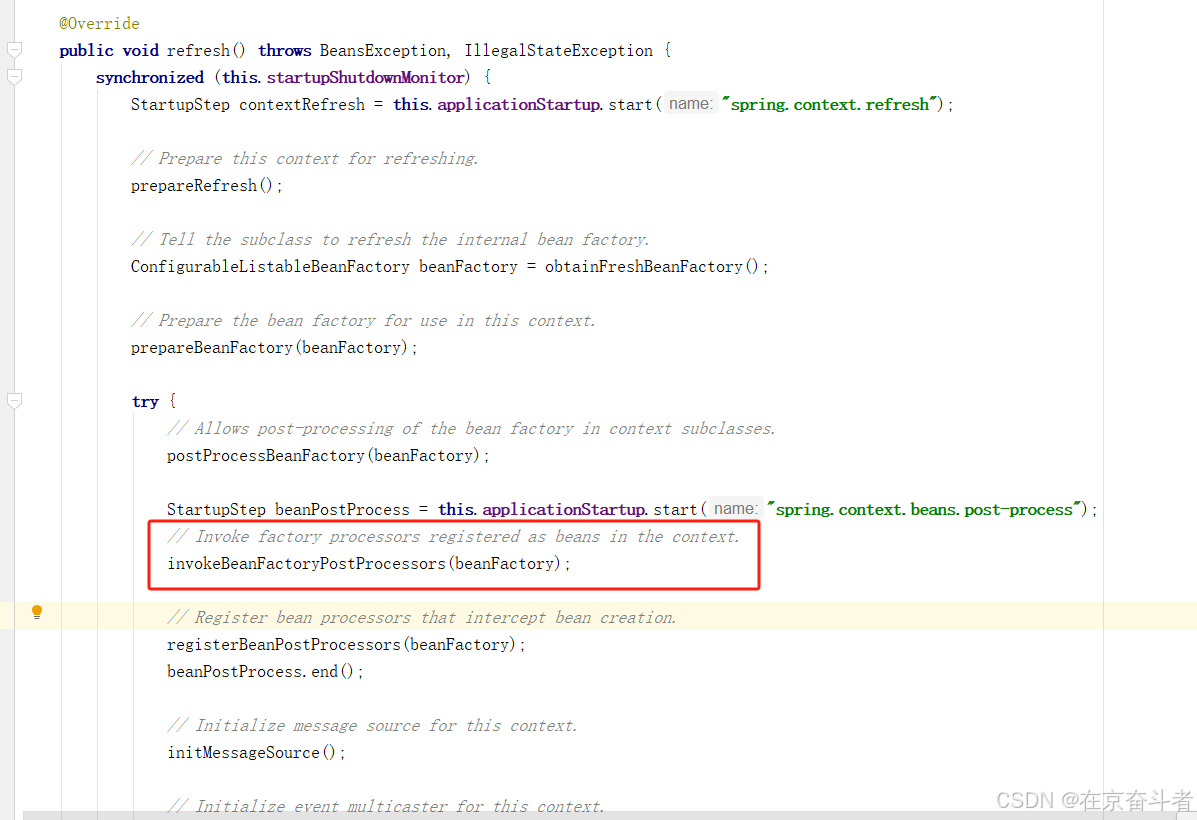
我们进入到invokeBeanFactoryPostProcessors方法内部,如下所示,我们重点关注第一行的代码PostProcessorRegistrationDelegate.invokeBeanFactoryPostProcessors(beanFactory, getBeanFactoryPostProcessors());
java
protected void invokeBeanFactoryPostProcessors(ConfigurableListableBeanFactory beanFactory) {
PostProcessorRegistrationDelegate.invokeBeanFactoryPostProcessors(beanFactory, getBeanFactoryPostProcessors());
// Detect a LoadTimeWeaver and prepare for weaving, if found in the meantime
// (e.g. through an @Bean method registered by ConfigurationClassPostProcessor)
if (!NativeDetector.inNativeImage() && beanFactory.getTempClassLoader() == null && beanFactory.containsBean(LOAD_TIME_WEAVER_BEAN_NAME)) {
beanFactory.addBeanPostProcessor(new LoadTimeWeaverAwareProcessor(beanFactory));
beanFactory.setTempClassLoader(new ContextTypeMatchClassLoader(beanFactory.getBeanClassLoader()));
}
}我们进入到我们方法内部,这个方法代码非常多,我们不用都关注,我们抽出重点需要关注的点关注即可。
java
public static void invokeBeanFactoryPostProcessors(
ConfigurableListableBeanFactory beanFactory, List<BeanFactoryPostProcessor> beanFactoryPostProcessors) {
// WARNING: Although it may appear that the body of this method can be easily
// refactored to avoid the use of multiple loops and multiple lists, the use
// of multiple lists and multiple passes over the names of processors is
// intentional. We must ensure that we honor the contracts for PriorityOrdered
// and Ordered processors. Specifically, we must NOT cause processors to be
// instantiated (via getBean() invocations) or registered in the ApplicationContext
// in the wrong order.
//
// Before submitting a pull request (PR) to change this method, please review the
// list of all declined PRs involving changes to PostProcessorRegistrationDelegate
// to ensure that your proposal does not result in a breaking change:
// https://github.com/spring-projects/spring-framework/issues?q=PostProcessorRegistrationDelegate+is%3Aclosed+label%3A%22status%3A+declined%22
// Invoke BeanDefinitionRegistryPostProcessors first, if any.
Set<String> processedBeans = new HashSet<>();
if (beanFactory instanceof BeanDefinitionRegistry) {
BeanDefinitionRegistry registry = (BeanDefinitionRegistry) beanFactory;
List<BeanFactoryPostProcessor> regularPostProcessors = new ArrayList<>();
List<BeanDefinitionRegistryPostProcessor> registryProcessors = new ArrayList<>();
for (BeanFactoryPostProcessor postProcessor : beanFactoryPostProcessors) {
if (postProcessor instanceof BeanDefinitionRegistryPostProcessor) {
BeanDefinitionRegistryPostProcessor registryProcessor =
(BeanDefinitionRegistryPostProcessor) postProcessor;
registryProcessor.postProcessBeanDefinitionRegistry(registry);
registryProcessors.add(registryProcessor);
}
else {
regularPostProcessors.add(postProcessor);
}
}
// Do not initialize FactoryBeans here: We need to leave all regular beans
// uninitialized to let the bean factory post-processors apply to them!
// Separate between BeanDefinitionRegistryPostProcessors that implement
// PriorityOrdered, Ordered, and the rest.
List<BeanDefinitionRegistryPostProcessor> currentRegistryProcessors = new ArrayList<>();
// First, invoke the BeanDefinitionRegistryPostProcessors that implement PriorityOrdered.
String[] postProcessorNames =
beanFactory.getBeanNamesForType(BeanDefinitionRegistryPostProcessor.class, true, false);
for (String ppName : postProcessorNames) {
if (beanFactory.isTypeMatch(ppName, PriorityOrdered.class)) {
currentRegistryProcessors.add(beanFactory.getBean(ppName, BeanDefinitionRegistryPostProcessor.class));
processedBeans.add(ppName);
}
}
sortPostProcessors(currentRegistryProcessors, beanFactory);
registryProcessors.addAll(currentRegistryProcessors);
invokeBeanDefinitionRegistryPostProcessors(currentRegistryProcessors, registry, beanFactory.getApplicationStartup());
currentRegistryProcessors.clear();
// Next, invoke the BeanDefinitionRegistryPostProcessors that implement Ordered.
postProcessorNames = beanFactory.getBeanNamesForType(BeanDefinitionRegistryPostProcessor.class, true, false);
for (String ppName : postProcessorNames) {
if (!processedBeans.contains(ppName) && beanFactory.isTypeMatch(ppName, Ordered.class)) {
currentRegistryProcessors.add(beanFactory.getBean(ppName, BeanDefinitionRegistryPostProcessor.class));
processedBeans.add(ppName);
}
}
sortPostProcessors(currentRegistryProcessors, beanFactory);
registryProcessors.addAll(currentRegistryProcessors);
invokeBeanDefinitionRegistryPostProcessors(currentRegistryProcessors, registry, beanFactory.getApplicationStartup());
currentRegistryProcessors.clear();
// Finally, invoke all other BeanDefinitionRegistryPostProcessors until no further ones appear.
boolean reiterate = true;
while (reiterate) {
reiterate = false;
postProcessorNames = beanFactory.getBeanNamesForType(BeanDefinitionRegistryPostProcessor.class, true, false);
for (String ppName : postProcessorNames) {
if (!processedBeans.contains(ppName)) {
currentRegistryProcessors.add(beanFactory.getBean(ppName, BeanDefinitionRegistryPostProcessor.class));
processedBeans.add(ppName);
reiterate = true;
}
}
sortPostProcessors(currentRegistryProcessors, beanFactory);
registryProcessors.addAll(currentRegistryProcessors);
invokeBeanDefinitionRegistryPostProcessors(currentRegistryProcessors, registry, beanFactory.getApplicationStartup());
currentRegistryProcessors.clear();
}
// Now, invoke the postProcessBeanFactory callback of all processors handled so far.
invokeBeanFactoryPostProcessors(registryProcessors, beanFactory);
invokeBeanFactoryPostProcessors(regularPostProcessors, beanFactory);
}
else {
// Invoke factory processors registered with the context instance.
invokeBeanFactoryPostProcessors(beanFactoryPostProcessors, beanFactory);
}
// Do not initialize FactoryBeans here: We need to leave all regular beans
// uninitialized to let the bean factory post-processors apply to them!
String[] postProcessorNames =
beanFactory.getBeanNamesForType(BeanFactoryPostProcessor.class, true, false);
// Separate between BeanFactoryPostProcessors that implement PriorityOrdered,
// Ordered, and the rest.
List<BeanFactoryPostProcessor> priorityOrderedPostProcessors = new ArrayList<>();
List<String> orderedPostProcessorNames = new ArrayList<>();
List<String> nonOrderedPostProcessorNames = new ArrayList<>();
for (String ppName : postProcessorNames) {
if (processedBeans.contains(ppName)) {
// skip - already processed in first phase above
}
else if (beanFactory.isTypeMatch(ppName, PriorityOrdered.class)) {
priorityOrderedPostProcessors.add(beanFactory.getBean(ppName, BeanFactoryPostProcessor.class));
}
else if (beanFactory.isTypeMatch(ppName, Ordered.class)) {
orderedPostProcessorNames.add(ppName);
}
else {
nonOrderedPostProcessorNames.add(ppName);
}
}
// First, invoke the BeanFactoryPostProcessors that implement PriorityOrdered.
sortPostProcessors(priorityOrderedPostProcessors, beanFactory);
invokeBeanFactoryPostProcessors(priorityOrderedPostProcessors, beanFactory);
// Next, invoke the BeanFactoryPostProcessors that implement Ordered.
List<BeanFactoryPostProcessor> orderedPostProcessors = new ArrayList<>(orderedPostProcessorNames.size());
for (String postProcessorName : orderedPostProcessorNames) {
orderedPostProcessors.add(beanFactory.getBean(postProcessorName, BeanFactoryPostProcessor.class));
}
sortPostProcessors(orderedPostProcessors, beanFactory);
invokeBeanFactoryPostProcessors(orderedPostProcessors, beanFactory);
// Finally, invoke all other BeanFactoryPostProcessors.
List<BeanFactoryPostProcessor> nonOrderedPostProcessors = new ArrayList<>(nonOrderedPostProcessorNames.size());
for (String postProcessorName : nonOrderedPostProcessorNames) {
nonOrderedPostProcessors.add(beanFactory.getBean(postProcessorName, BeanFactoryPostProcessor.class));
}
invokeBeanFactoryPostProcessors(nonOrderedPostProcessors, beanFactory);
// Clear cached merged bean definitions since the post-processors might have
// modified the original metadata, e.g. replacing placeholders in values...
beanFactory.clearMetadataCache();
}下面我把重点需要关注的代码粘贴出来,其中下面第一行代码是通过BeanDefinitionRegistryPostProcessor这个类找到我们在上面2.1中注解解析器中提到的对应的beanName,这里对应的beanName是org.springframework.context.annotation.internalConfigurationAnnotationProcessor(我们在2.1中就截图说明了这个beanName对应了ConfigurationClassPostProcessor这个根beanDefinition,而ConfigurationClassPostProcessor又是BeanDefinitionRegistryPostProcessor的实现类)
java
String[] postProcessorNames =
beanFactory.getBeanNamesForType(BeanDefinitionRegistryPostProcessor.class, true, false);
for (String ppName : postProcessorNames) {
if (beanFactory.isTypeMatch(ppName, PriorityOrdered.class)) {
currentRegistryProcessors.add(beanFactory.getBean(ppName, BeanDefinitionRegistryPostProcessor.class));
processedBeans.add(ppName);
}
}
sortPostProcessors(currentRegistryProcessors, beanFactory);
registryProcessors.addAll(currentRegistryProcessors);
invokeBeanDefinitionRegistryPostProcessors(currentRegistryProcessors, registry, beanFactory.getApplicationStartup());接下来for循环中就是判断org.springframework.context.annotation.internalConfigurationAnnotationProcessor是否匹配,我们通过2.1节可以知道DefaultListableBeanFactory这个组件是支持优先级的,因此走到if内部,currentRegistryProcessors.add(beanFactory.getBean(ppName, BeanDefinitionRegistryPostProcessor.class));这行代码便是要通过ppName(也就是我们前面提到的beanName)获取对应的beandefinition,我们这里显然应该得到的就是ConfigurationClassPostProcessor
java
for (String ppName : postProcessorNames) {
if (beanFactory.isTypeMatch(ppName, PriorityOrdered.class)) {
currentRegistryProcessors.add(beanFactory.getBean(ppName, BeanDefinitionRegistryPostProcessor.class));
processedBeans.add(ppName);
}
}然后我们就重点关注invokeBeanDefinitionRegistryPostProcessors(currentRegistryProcessors, registry, beanFactory.getApplicationStartup());这行代码了。这个方法内部代码如下,这里面重点关注的是for循环内部的postProcessor.postProcessBeanDefinitionRegistry(registry);这行代码。
java
private static void invokeBeanDefinitionRegistryPostProcessors(
Collection<? extends BeanDefinitionRegistryPostProcessor> postProcessors, BeanDefinitionRegistry registry, ApplicationStartup applicationStartup) {
for (BeanDefinitionRegistryPostProcessor postProcessor : postProcessors) {
StartupStep postProcessBeanDefRegistry = applicationStartup.start("spring.context.beandef-registry.post-process")
.tag("postProcessor", postProcessor::toString);
postProcessor.postProcessBeanDefinitionRegistry(registry);
postProcessBeanDefRegistry.end();
}
}postProcessBeanDefinitionRegistry方法源码如下,在这个方法内部我们重点关注最后面那行processConfigBeanDefinitions(registry);
java
public void postProcessBeanDefinitionRegistry(BeanDefinitionRegistry registry) {
int registryId = System.identityHashCode(registry);
if (this.registriesPostProcessed.contains(registryId)) {
throw new IllegalStateException(
"postProcessBeanDefinitionRegistry already called on this post-processor against " + registry);
}
if (this.factoriesPostProcessed.contains(registryId)) {
throw new IllegalStateException(
"postProcessBeanFactory already called on this post-processor against " + registry);
}
this.registriesPostProcessed.add(registryId);
processConfigBeanDefinitions(registry);
}processConfigBeanDefinitions方法源码如下,又是有很多代码,我们重点关注的是parser.parse(candidates)方法,如下图所示。
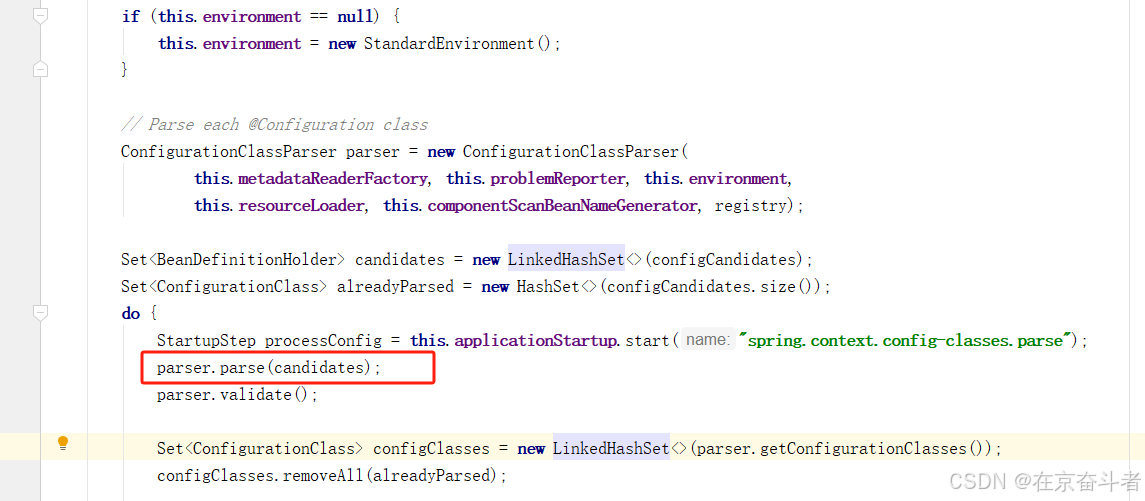
java
public void processConfigBeanDefinitions(BeanDefinitionRegistry registry) {
List<BeanDefinitionHolder> configCandidates = new ArrayList<>();
String[] candidateNames = registry.getBeanDefinitionNames();
for (String beanName : candidateNames) {
BeanDefinition beanDef = registry.getBeanDefinition(beanName);
if (beanDef.getAttribute(ConfigurationClassUtils.CONFIGURATION_CLASS_ATTRIBUTE) != null) {
if (logger.isDebugEnabled()) {
logger.debug("Bean definition has already been processed as a configuration class: " + beanDef);
}
}
else if (ConfigurationClassUtils.checkConfigurationClassCandidate(beanDef, this.metadataReaderFactory)) {
configCandidates.add(new BeanDefinitionHolder(beanDef, beanName));
}
}
// Return immediately if no @Configuration classes were found
if (configCandidates.isEmpty()) {
return;
}
// Sort by previously determined @Order value, if applicable
configCandidates.sort((bd1, bd2) -> {
int i1 = ConfigurationClassUtils.getOrder(bd1.getBeanDefinition());
int i2 = ConfigurationClassUtils.getOrder(bd2.getBeanDefinition());
return Integer.compare(i1, i2);
});
// Detect any custom bean name generation strategy supplied through the enclosing application context
SingletonBeanRegistry sbr = null;
if (registry instanceof SingletonBeanRegistry) {
sbr = (SingletonBeanRegistry) registry;
if (!this.localBeanNameGeneratorSet) {
BeanNameGenerator generator = (BeanNameGenerator) sbr.getSingleton(
AnnotationConfigUtils.CONFIGURATION_BEAN_NAME_GENERATOR);
if (generator != null) {
this.componentScanBeanNameGenerator = generator;
this.importBeanNameGenerator = generator;
}
}
}
if (this.environment == null) {
this.environment = new StandardEnvironment();
}
// Parse each @Configuration class
ConfigurationClassParser parser = new ConfigurationClassParser(
this.metadataReaderFactory, this.problemReporter, this.environment,
this.resourceLoader, this.componentScanBeanNameGenerator, registry);
Set<BeanDefinitionHolder> candidates = new LinkedHashSet<>(configCandidates);
Set<ConfigurationClass> alreadyParsed = new HashSet<>(configCandidates.size());
do {
StartupStep processConfig = this.applicationStartup.start("spring.context.config-classes.parse");
parser.parse(candidates);
parser.validate();
Set<ConfigurationClass> configClasses = new LinkedHashSet<>(parser.getConfigurationClasses());
configClasses.removeAll(alreadyParsed);
// Read the model and create bean definitions based on its content
if (this.reader == null) {
this.reader = new ConfigurationClassBeanDefinitionReader(
registry, this.sourceExtractor, this.resourceLoader, this.environment,
this.importBeanNameGenerator, parser.getImportRegistry());
}
this.reader.loadBeanDefinitions(configClasses);
alreadyParsed.addAll(configClasses);
processConfig.tag("classCount", () -> String.valueOf(configClasses.size())).end();
candidates.clear();
if (registry.getBeanDefinitionCount() > candidateNames.length) {
String[] newCandidateNames = registry.getBeanDefinitionNames();
Set<String> oldCandidateNames = new HashSet<>(Arrays.asList(candidateNames));
Set<String> alreadyParsedClasses = new HashSet<>();
for (ConfigurationClass configurationClass : alreadyParsed) {
alreadyParsedClasses.add(configurationClass.getMetadata().getClassName());
}
for (String candidateName : newCandidateNames) {
if (!oldCandidateNames.contains(candidateName)) {
BeanDefinition bd = registry.getBeanDefinition(candidateName);
if (ConfigurationClassUtils.checkConfigurationClassCandidate(bd, this.metadataReaderFactory) &&
!alreadyParsedClasses.contains(bd.getBeanClassName())) {
candidates.add(new BeanDefinitionHolder(bd, candidateName));
}
}
}
candidateNames = newCandidateNames;
}
}
while (!candidates.isEmpty());
// Register the ImportRegistry as a bean in order to support ImportAware @Configuration classes
if (sbr != null && !sbr.containsSingleton(IMPORT_REGISTRY_BEAN_NAME)) {
sbr.registerSingleton(IMPORT_REGISTRY_BEAN_NAME, parser.getImportRegistry());
}
if (this.metadataReaderFactory instanceof CachingMetadataReaderFactory) {
// Clear cache in externally provided MetadataReaderFactory; this is a no-op
// for a shared cache since it'll be cleared by the ApplicationContext.
((CachingMetadataReaderFactory) this.metadataReaderFactory).clearCache();
}
}我们继续看parse方法内的源码,可以看到try中if、else if还有else都调用了本类中一个parse方法名一样,参数不一样的parse方法,这个是我们重点关注的。
java
public void parse(Set < BeanDefinitionHolder > configCandidates) {
for (BeanDefinitionHolder holder: configCandidates) {
BeanDefinition bd = holder.getBeanDefinition();
try {
if (bd instanceof AnnotatedBeanDefinition) {
parse(((AnnotatedBeanDefinition) bd).getMetadata(), holder.getBeanName());
} else if (bd instanceof AbstractBeanDefinition && ((AbstractBeanDefinition) bd).hasBeanClass()) {
parse(((AbstractBeanDefinition) bd).getBeanClass(), holder.getBeanName());
} else {
parse(bd.getBeanClassName(), holder.getBeanName());
}
} catch (BeanDefinitionStoreException ex) {
throw ex;
} catch (Throwable ex) {
throw new BeanDefinitionStoreException(
"Failed to parse configuration class [" + bd.getBeanClassName() + "]", ex);
}
}
this.deferredImportSelectorHandler.process();
}这个同名prase方法内部代码如下。
java
protected final void parse(AnnotationMetadata metadata, String beanName) throws IOException {
processConfigurationClass(new ConfigurationClass(metadata, beanName), DEFAULT_EXCLUSION_FILTER);
}我们继续到processConfigurationClass方法内部查看源码,如下所示,
java
protected void processConfigurationClass(ConfigurationClass configClass, Predicate < String > filter) throws IOException {
if (this.conditionEvaluator.shouldSkip(configClass.getMetadata(), ConfigurationPhase.PARSE_CONFIGURATION)) {
return;
}
ConfigurationClass existingClass = this.configurationClasses.get(configClass);
if (existingClass != null) {
if (configClass.isImported()) {
if (existingClass.isImported()) {
existingClass.mergeImportedBy(configClass);
}
// Otherwise ignore new imported config class; existing non-imported class overrides it.
return;
} else {
// Explicit bean definition found, probably replacing an import.
// Let's remove the old one and go with the new one.
this.configurationClasses.remove(configClass);
this.knownSuperclasses.values().removeIf(configClass::equals);
}
}
// Recursively process the configuration class and its superclass hierarchy.
SourceClass sourceClass = asSourceClass(configClass, filter);
do {
sourceClass = doProcessConfigurationClass(configClass, sourceClass, filter);
}
while (sourceClass != null);
this.configurationClasses.put(configClass, configClass);
}我们需要重点关注的代码是如下图所示地方,

其中componentScans运行得到的结果如下图所示,可以看到basePackages下面就是我们的AppConfig配置类中指定要扫描的包路径。
 接着看componentScanParser.parse方法的源码,又是一大坨代码,我们直接看最后一行代码return scanner.doScan(StringUtils.toStringArray(basePackages));
接着看componentScanParser.parse方法的源码,又是一大坨代码,我们直接看最后一行代码return scanner.doScan(StringUtils.toStringArray(basePackages));
java
public Set < BeanDefinitionHolder > parse(AnnotationAttributes componentScan, String declaringClass) {
ClassPathBeanDefinitionScanner scanner = new ClassPathBeanDefinitionScanner(this.registry,
componentScan.getBoolean("useDefaultFilters"), this.environment, this.resourceLoader);
Class <? extends BeanNameGenerator > generatorClass = componentScan.getClass("nameGenerator");
boolean useInheritedGenerator = (BeanNameGenerator.class == generatorClass);
scanner.setBeanNameGenerator(useInheritedGenerator ? this.beanNameGenerator :
BeanUtils.instantiateClass(generatorClass));
ScopedProxyMode scopedProxyMode = componentScan.getEnum("scopedProxy");
if (scopedProxyMode != ScopedProxyMode.DEFAULT) {
scanner.setScopedProxyMode(scopedProxyMode);
} else {
Class <? extends ScopeMetadataResolver > resolverClass = componentScan.getClass("scopeResolver");
scanner.setScopeMetadataResolver(BeanUtils.instantiateClass(resolverClass));
}
scanner.setResourcePattern(componentScan.getString("resourcePattern"));
for (AnnotationAttributes includeFilterAttributes: componentScan.getAnnotationArray("includeFilters")) {
List < TypeFilter > typeFilters = TypeFilterUtils.createTypeFiltersFor(includeFilterAttributes, this.environment,
this.resourceLoader, this.registry);
for (TypeFilter typeFilter: typeFilters) {
scanner.addIncludeFilter(typeFilter);
}
}
for (AnnotationAttributes excludeFilterAttributes: componentScan.getAnnotationArray("excludeFilters")) {
List < TypeFilter > typeFilters = TypeFilterUtils.createTypeFiltersFor(excludeFilterAttributes, this.environment,
this.resourceLoader, this.registry);
for (TypeFilter typeFilter: typeFilters) {
scanner.addExcludeFilter(typeFilter);
}
}
boolean lazyInit = componentScan.getBoolean("lazyInit");
if (lazyInit) {
scanner.getBeanDefinitionDefaults().setLazyInit(true);
}
Set < String > basePackages = new LinkedHashSet < > ();
String[] basePackagesArray = componentScan.getStringArray("basePackages");
for (String pkg: basePackagesArray) {
String[] tokenized = StringUtils.tokenizeToStringArray(this.environment.resolvePlaceholders(pkg),
ConfigurableApplicationContext.CONFIG_LOCATION_DELIMITERS);
Collections.addAll(basePackages, tokenized);
}
for (Class <? > clazz: componentScan.getClassArray("basePackageClasses")) {
basePackages.add(ClassUtils.getPackageName(clazz));
}
if (basePackages.isEmpty()) {
basePackages.add(ClassUtils.getPackageName(declaringClass));
}
scanner.addExcludeFilter(new AbstractTypeHierarchyTraversingFilter(false, false) {@
Override
protected boolean matchClassName(String className) {
return declaringClass.equals(className);
}
});
return scanner.doScan(StringUtils.toStringArray(basePackages));
}doScan内部源码如下,我们重点关注其中的外层for循环中的第一行代码Set<BeanDefinition> candidates = findCandidateComponents(basePackage);
java
protected Set < BeanDefinitionHolder > doScan(String...basePackages) {
Assert.notEmpty(basePackages, "At least one base package must be specified");
Set < BeanDefinitionHolder > beanDefinitions = new LinkedHashSet < > ();
for (String basePackage: basePackages) {
Set < BeanDefinition > candidates = findCandidateComponents(basePackage);
for (BeanDefinition candidate: candidates) {
ScopeMetadata scopeMetadata = this.scopeMetadataResolver.resolveScopeMetadata(candidate);
candidate.setScope(scopeMetadata.getScopeName());
String beanName = this.beanNameGenerator.generateBeanName(candidate, this.registry);
if (candidate instanceof AbstractBeanDefinition) {
postProcessBeanDefinition((AbstractBeanDefinition) candidate, beanName);
}
if (candidate instanceof AnnotatedBeanDefinition) {
AnnotationConfigUtils.processCommonDefinitionAnnotations((AnnotatedBeanDefinition) candidate);
}
if (checkCandidate(beanName, candidate)) {
BeanDefinitionHolder definitionHolder = new BeanDefinitionHolder(candidate, beanName);
definitionHolder =
AnnotationConfigUtils.applyScopedProxyMode(scopeMetadata, definitionHolder, this.registry);
beanDefinitions.add(definitionHolder);
registerBeanDefinition(definitionHolder, this.registry);
}
}
}
return beanDefinitions;
}findCandidateComponents方法源码如下:我们重点关注的是return scanCandidateComponents(basePackage);这行代码。
java
public Set < BeanDefinition > findCandidateComponents(String basePackage) {
if (this.componentsIndex != null && indexSupportsIncludeFilters()) {
return addCandidateComponentsFromIndex(this.componentsIndex, basePackage);
} else {
return scanCandidateComponents(basePackage);
}
}scanCandidateComponents方法源码如下所示,其中packageSearchPath获取到的值如下图,很明显就是要把com/example/bean包下的所有类都扫描出来

下面resources这个变量的值刚好可以验证我们的猜想,如下图所示。从而到这里就可以知道我们是在这一步将AppConfig配置类中指定的com/example/bean包下的所有类扫描出来的,并且后面会组装成BeanDefinition存起来,从而给bean的实例化、初始化提供基础条件。

java
private Set < BeanDefinition > scanCandidateComponents(String basePackage) {
Set < BeanDefinition > candidates = new LinkedHashSet < > ();
try {
String packageSearchPath = ResourcePatternResolver.CLASSPATH_ALL_URL_PREFIX +
resolveBasePackage(basePackage) + '/' + this.resourcePattern;
Resource[] resources = getResourcePatternResolver().getResources(packageSearchPath);
boolean traceEnabled = logger.isTraceEnabled();
boolean debugEnabled = logger.isDebugEnabled();
for (Resource resource: resources) {
if (traceEnabled) {
logger.trace("Scanning " + resource);
}
try {
MetadataReader metadataReader = getMetadataReaderFactory().getMetadataReader(resource);
if (isCandidateComponent(metadataReader)) {
ScannedGenericBeanDefinition sbd = new ScannedGenericBeanDefinition(metadataReader);
sbd.setSource(resource);
if (isCandidateComponent(sbd)) {
if (debugEnabled) {
logger.debug("Identified candidate component class: " + resource);
}
candidates.add(sbd);
} else {
if (debugEnabled) {
logger.debug("Ignored because not a concrete top-level class: " + resource);
}
}
} else {
if (traceEnabled) {
logger.trace("Ignored because not matching any filter: " + resource);
}
}
} catch (FileNotFoundException ex) {
if (traceEnabled) {
logger.trace("Ignored non-readable " + resource + ": " + ex.getMessage());
}
} catch (Throwable ex) {
throw new BeanDefinitionStoreException(
"Failed to read candidate component class: " + resource, ex);
}
}
} catch (IOException ex) {
throw new BeanDefinitionStoreException("I/O failure during classpath scanning", ex);
}
return candidates;
}五、实例化
在上面invokeBeanFactoryPostProcessors方法执行完后,我们已经扫描出了com.example.bean目录下所有类并生成了对应的BeanDefinition,用于后面创建实例。下面通过源码来了解一下这块。我们要重点关注的是spring的refresh方法中的finishBeanFactoryInitialization(beanFactory);这行代码。
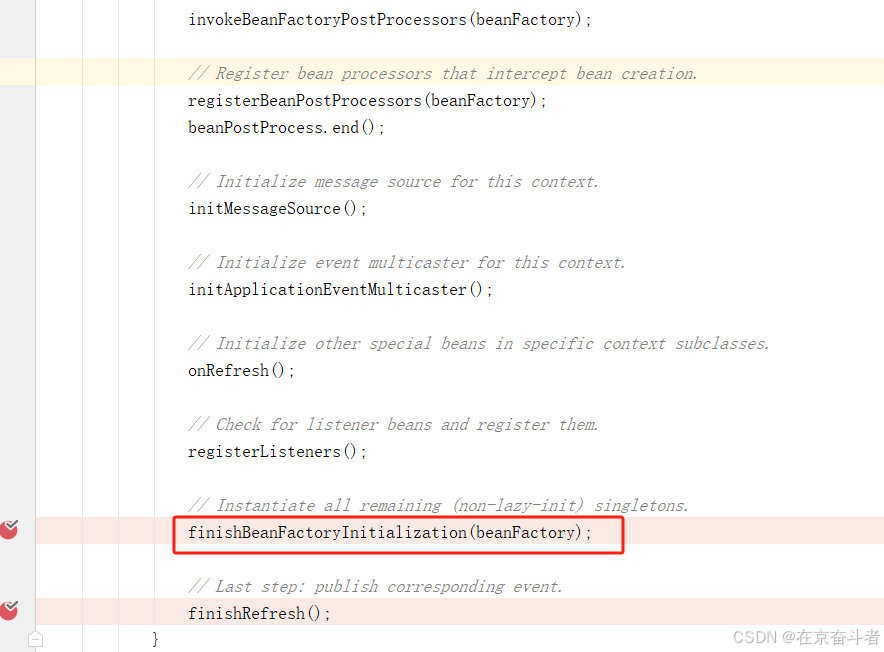
我们进入finishBeanFactoryInitialization方法内部,代码挺多,我们跳过不重要的,直接看这个方法的最后一行beanFactory.preInstantiateSingletons();内的实现逻辑
java
protected void finishBeanFactoryInitialization(ConfigurableListableBeanFactory beanFactory) {
// Initialize conversion service for this context.
if (beanFactory.containsBean(CONVERSION_SERVICE_BEAN_NAME) &&
beanFactory.isTypeMatch(CONVERSION_SERVICE_BEAN_NAME, ConversionService.class)) {
beanFactory.setConversionService(
beanFactory.getBean(CONVERSION_SERVICE_BEAN_NAME, ConversionService.class));
}
// Register a default embedded value resolver if no BeanFactoryPostProcessor
// (such as a PropertySourcesPlaceholderConfigurer bean) registered any before:
// at this point, primarily for resolution in annotation attribute values.
if (!beanFactory.hasEmbeddedValueResolver()) {
beanFactory.addEmbeddedValueResolver(strVal - > getEnvironment().resolvePlaceholders(strVal));
}
// Initialize LoadTimeWeaverAware beans early to allow for registering their transformers early.
String[] weaverAwareNames = beanFactory.getBeanNamesForType(LoadTimeWeaverAware.class, false, false);
for (String weaverAwareName: weaverAwareNames) {
getBean(weaverAwareName);
}
// Stop using the temporary ClassLoader for type matching.
beanFactory.setTempClassLoader(null);
// Allow for caching all bean definition metadata, not expecting further changes.
beanFactory.freezeConfiguration();
// Instantiate all remaining (non-lazy-init) singletons.
beanFactory.preInstantiateSingletons();
}preInstantiateSingletons方法内部代码如下,我们要关注的是for循环中的getBean(beanName)方法。
java
public void preInstantiateSingletons() throws BeansException {
if (logger.isTraceEnabled()) {
logger.trace("Pre-instantiating singletons in " + this);
}
// Iterate over a copy to allow for init methods which in turn register new bean definitions.
// While this may not be part of the regular factory bootstrap, it does otherwise work fine.
List < String > beanNames = new ArrayList < > (this.beanDefinitionNames);
// Trigger initialization of all non-lazy singleton beans...
for (String beanName: beanNames) {
RootBeanDefinition bd = getMergedLocalBeanDefinition(beanName);
if (!bd.isAbstract() && bd.isSingleton() && !bd.isLazyInit()) {
if (isFactoryBean(beanName)) {
Object bean = getBean(FACTORY_BEAN_PREFIX + beanName);
if (bean instanceof FactoryBean) {
FactoryBean <? > factory = (FactoryBean <? > ) bean;
boolean isEagerInit;
if (System.getSecurityManager() != null && factory instanceof SmartFactoryBean) {
isEagerInit = AccessController.doPrivileged(
(PrivilegedAction < Boolean > )((SmartFactoryBean <? > ) factory)::isEagerInit,
getAccessControlContext());
} else {
isEagerInit = (factory instanceof SmartFactoryBean &&
((SmartFactoryBean <? > ) factory).isEagerInit());
}
if (isEagerInit) {
getBean(beanName);
}
}
} else {
getBean(beanName);
}
}
}
// Trigger post-initialization callback for all applicable beans...
for (String beanName: beanNames) {
Object singletonInstance = getSingleton(beanName);
if (singletonInstance instanceof SmartInitializingSingleton) {
StartupStep smartInitialize = this.getApplicationStartup().start("spring.beans.smart-initialize")
.tag("beanName", beanName);
SmartInitializingSingleton smartSingleton = (SmartInitializingSingleton) singletonInstance;
if (System.getSecurityManager() != null) {
AccessController.doPrivileged((PrivilegedAction < Object > )() - > {
smartSingleton.afterSingletonsInstantiated();
return null;
}, getAccessControlContext());
} else {
smartSingleton.afterSingletonsInstantiated();
}
smartInitialize.end();
}
}
}getBean(beanName);方法源码如下
java
public Object getBean(String name) throws BeansException {
return doGetBean(name, null, null, false);
}然后接着看doGetBean方法的源码,如下,我们重点关注的是if (mbd.isSingleton())这个if判断的内部的return createBean(beanName, mbd, args);这行代码。
java
protected < T > T doGetBean(
String name, @Nullable Class < T > requiredType, @Nullable Object[] args, boolean typeCheckOnly)
throws BeansException {
String beanName = transformedBeanName(name);
Object beanInstance;
// Eagerly check singleton cache for manually registered singletons.
Object sharedInstance = getSingleton(beanName);
if (sharedInstance != null && args == null) {
if (logger.isTraceEnabled()) {
if (isSingletonCurrentlyInCreation(beanName)) {
logger.trace("Returning eagerly cached instance of singleton bean '" + beanName +
"' that is not fully initialized yet - a consequence of a circular reference");
} else {
logger.trace("Returning cached instance of singleton bean '" + beanName + "'");
}
}
beanInstance = getObjectForBeanInstance(sharedInstance, name, beanName, null);
} else {
// Fail if we're already creating this bean instance:
// We're assumably within a circular reference.
if (isPrototypeCurrentlyInCreation(beanName)) {
throw new BeanCurrentlyInCreationException(beanName);
}
// Check if bean definition exists in this factory.
BeanFactory parentBeanFactory = getParentBeanFactory();
if (parentBeanFactory != null && !containsBeanDefinition(beanName)) {
// Not found -> check parent.
String nameToLookup = originalBeanName(name);
if (parentBeanFactory instanceof AbstractBeanFactory) {
return ((AbstractBeanFactory) parentBeanFactory).doGetBean(
nameToLookup, requiredType, args, typeCheckOnly);
} else if (args != null) {
// Delegation to parent with explicit args.
return (T) parentBeanFactory.getBean(nameToLookup, args);
} else if (requiredType != null) {
// No args -> delegate to standard getBean method.
return parentBeanFactory.getBean(nameToLookup, requiredType);
} else {
return (T) parentBeanFactory.getBean(nameToLookup);
}
}
if (!typeCheckOnly) {
markBeanAsCreated(beanName);
}
StartupStep beanCreation = this.applicationStartup.start("spring.beans.instantiate")
.tag("beanName", name);
try {
if (requiredType != null) {
beanCreation.tag("beanType", requiredType::toString);
}
RootBeanDefinition mbd = getMergedLocalBeanDefinition(beanName);
checkMergedBeanDefinition(mbd, beanName, args);
// Guarantee initialization of beans that the current bean depends on.
String[] dependsOn = mbd.getDependsOn();
if (dependsOn != null) {
for (String dep: dependsOn) {
if (isDependent(beanName, dep)) {
throw new BeanCreationException(mbd.getResourceDescription(), beanName,
"Circular depends-on relationship between '" + beanName + "' and '" + dep + "'");
}
registerDependentBean(dep, beanName);
try {
getBean(dep);
} catch (NoSuchBeanDefinitionException ex) {
throw new BeanCreationException(mbd.getResourceDescription(), beanName,
"'" + beanName + "' depends on missing bean '" + dep + "'", ex);
}
}
}
// Create bean instance.
if (mbd.isSingleton()) {
sharedInstance = getSingleton(beanName, () - > {
try {
return createBean(beanName, mbd, args);
} catch (BeansException ex) {
// Explicitly remove instance from singleton cache: It might have been put there
// eagerly by the creation process, to allow for circular reference resolution.
// Also remove any beans that received a temporary reference to the bean.
destroySingleton(beanName);
throw ex;
}
});
beanInstance = getObjectForBeanInstance(sharedInstance, name, beanName, mbd);
} else if (mbd.isPrototype()) {
// It's a prototype -> create a new instance.
Object prototypeInstance = null;
try {
beforePrototypeCreation(beanName);
prototypeInstance = createBean(beanName, mbd, args);
} finally {
afterPrototypeCreation(beanName);
}
beanInstance = getObjectForBeanInstance(prototypeInstance, name, beanName, mbd);
} else {
String scopeName = mbd.getScope();
if (!StringUtils.hasLength(scopeName)) {
throw new IllegalStateException("No scope name defined for bean '" + beanName + "'");
}
Scope scope = this.scopes.get(scopeName);
if (scope == null) {
throw new IllegalStateException("No Scope registered for scope name '" + scopeName + "'");
}
try {
Object scopedInstance = scope.get(beanName, () - > {
beforePrototypeCreation(beanName);
try {
return createBean(beanName, mbd, args);
} finally {
afterPrototypeCreation(beanName);
}
});
beanInstance = getObjectForBeanInstance(scopedInstance, name, beanName, mbd);
} catch (IllegalStateException ex) {
throw new ScopeNotActiveException(beanName, scopeName, ex);
}
}
} catch (BeansException ex) {
beanCreation.tag("exception", ex.getClass().toString());
beanCreation.tag("message", String.valueOf(ex.getMessage()));
cleanupAfterBeanCreationFailure(beanName);
throw ex;
} finally {
beanCreation.end();
}
}
return adaptBeanInstance(name, beanInstance, requiredType);
}然后看createBean方法内部源码如下,这里我们重点关注的是最下面那个try中的Object beanInstance = doCreateBean(beanName, mbdToUse, args);这行代码。
java
protected Object createBean(String beanName, RootBeanDefinition mbd, @Nullable Object[] args)
throws BeanCreationException {
if (logger.isTraceEnabled()) {
logger.trace("Creating instance of bean '" + beanName + "'");
}
RootBeanDefinition mbdToUse = mbd;
// Make sure bean class is actually resolved at this point, and
// clone the bean definition in case of a dynamically resolved Class
// which cannot be stored in the shared merged bean definition.
Class <? > resolvedClass = resolveBeanClass(mbd, beanName);
if (resolvedClass != null && !mbd.hasBeanClass() && mbd.getBeanClassName() != null) {
mbdToUse = new RootBeanDefinition(mbd);
mbdToUse.setBeanClass(resolvedClass);
}
// Prepare method overrides.
try {
mbdToUse.prepareMethodOverrides();
} catch (BeanDefinitionValidationException ex) {
throw new BeanDefinitionStoreException(mbdToUse.getResourceDescription(),
beanName, "Validation of method overrides failed", ex);
}
try {
// Give BeanPostProcessors a chance to return a proxy instead of the target bean instance.
Object bean = resolveBeforeInstantiation(beanName, mbdToUse);
if (bean != null) {
return bean;
}
} catch (Throwable ex) {
throw new BeanCreationException(mbdToUse.getResourceDescription(), beanName,
"BeanPostProcessor before instantiation of bean failed", ex);
}
try {
Object beanInstance = doCreateBean(beanName, mbdToUse, args);
if (logger.isTraceEnabled()) {
logger.trace("Finished creating instance of bean '" + beanName + "'");
}
return beanInstance;
} catch (BeanCreationException | ImplicitlyAppearedSingletonException ex) {
// A previously detected exception with proper bean creation context already,
// or illegal singleton state to be communicated up to DefaultSingletonBeanRegistry.
throw ex;
} catch (Throwable ex) {
throw new BeanCreationException(
mbdToUse.getResourceDescription(), beanName, "Unexpected exception during bean creation", ex);
}
}然后我们进入到doCreateBean内部,我们现在要关注实例化,因此很明显,我们应该重点关注的是if (instanceWrapper == null) 这个if条件内的instanceWrapper = createBeanInstance(beanName, mbd, args);这行代码。
java
protected Object doCreateBean(String beanName, RootBeanDefinition mbd, @Nullable Object[] args)
throws BeanCreationException {
// Instantiate the bean.
BeanWrapper instanceWrapper = null;
if (mbd.isSingleton()) {
instanceWrapper = this.factoryBeanInstanceCache.remove(beanName);
}
if (instanceWrapper == null) {
instanceWrapper = createBeanInstance(beanName, mbd, args);
}
Object bean = instanceWrapper.getWrappedInstance();
Class <? > beanType = instanceWrapper.getWrappedClass();
if (beanType != NullBean.class) {
mbd.resolvedTargetType = beanType;
}
// Allow post-processors to modify the merged bean definition.
synchronized(mbd.postProcessingLock) {
if (!mbd.postProcessed) {
try {
applyMergedBeanDefinitionPostProcessors(mbd, beanType, beanName);
} catch (Throwable ex) {
throw new BeanCreationException(mbd.getResourceDescription(), beanName,
"Post-processing of merged bean definition failed", ex);
}
mbd.postProcessed = true;
}
}
// Eagerly cache singletons to be able to resolve circular references
// even when triggered by lifecycle interfaces like BeanFactoryAware.
boolean earlySingletonExposure = (mbd.isSingleton() && this.allowCircularReferences &&
isSingletonCurrentlyInCreation(beanName));
if (earlySingletonExposure) {
if (logger.isTraceEnabled()) {
logger.trace("Eagerly caching bean '" + beanName +
"' to allow for resolving potential circular references");
}
addSingletonFactory(beanName, () - > getEarlyBeanReference(beanName, mbd, bean));
}
// Initialize the bean instance.
Object exposedObject = bean;
try {
populateBean(beanName, mbd, instanceWrapper);
exposedObject = initializeBean(beanName, exposedObject, mbd);
} catch (Throwable ex) {
if (ex instanceof BeanCreationException && beanName.equals(((BeanCreationException) ex).getBeanName())) {
throw (BeanCreationException) ex;
} else {
throw new BeanCreationException(
mbd.getResourceDescription(), beanName, "Initialization of bean failed", ex);
}
}
if (earlySingletonExposure) {
Object earlySingletonReference = getSingleton(beanName, false);
if (earlySingletonReference != null) {
if (exposedObject == bean) {
exposedObject = earlySingletonReference;
} else if (!this.allowRawInjectionDespiteWrapping && hasDependentBean(beanName)) {
String[] dependentBeans = getDependentBeans(beanName);
Set < String > actualDependentBeans = new LinkedHashSet < > (dependentBeans.length);
for (String dependentBean: dependentBeans) {
if (!removeSingletonIfCreatedForTypeCheckOnly(dependentBean)) {
actualDependentBeans.add(dependentBean);
}
}
if (!actualDependentBeans.isEmpty()) {
throw new BeanCurrentlyInCreationException(beanName,
"Bean with name '" + beanName + "' has been injected into other beans [" +
StringUtils.collectionToCommaDelimitedString(actualDependentBeans) +
"] in its raw version as part of a circular reference, but has eventually been " +
"wrapped. This means that said other beans do not use the final version of the " +
"bean. This is often the result of over-eager type matching - consider using " +
"'getBeanNamesForType' with the 'allowEagerInit' flag turned off, for example.");
}
}
}
}
// Register bean as disposable.
try {
registerDisposableBeanIfNecessary(beanName, bean, mbd);
} catch (BeanDefinitionValidationException ex) {
throw new BeanCreationException(
mbd.getResourceDescription(), beanName, "Invalid destruction signature", ex);
}
return exposedObject;
}然后我们看createBeanInstance方法内部源码,如下,我们重点关注的是最后一行代码return instantiateBean(beanName, mbd);
java
protected BeanWrapper createBeanInstance(String beanName, RootBeanDefinition mbd, @Nullable Object[] args) {
// Make sure bean class is actually resolved at this point.
Class <? > beanClass = resolveBeanClass(mbd, beanName);
if (beanClass != null && !Modifier.isPublic(beanClass.getModifiers()) && !mbd.isNonPublicAccessAllowed()) {
throw new BeanCreationException(mbd.getResourceDescription(), beanName,
"Bean class isn't public, and non-public access not allowed: " + beanClass.getName());
}
Supplier <? > instanceSupplier = mbd.getInstanceSupplier();
if (instanceSupplier != null) {
return obtainFromSupplier(instanceSupplier, beanName);
}
if (mbd.getFactoryMethodName() != null) {
return instantiateUsingFactoryMethod(beanName, mbd, args);
}
// Shortcut when re-creating the same bean...
boolean resolved = false;
boolean autowireNecessary = false;
if (args == null) {
synchronized(mbd.constructorArgumentLock) {
if (mbd.resolvedConstructorOrFactoryMethod != null) {
resolved = true;
autowireNecessary = mbd.constructorArgumentsResolved;
}
}
}
if (resolved) {
if (autowireNecessary) {
return autowireConstructor(beanName, mbd, null, null);
} else {
return instantiateBean(beanName, mbd);
}
}
// Candidate constructors for autowiring?
Constructor <? > [] ctors = determineConstructorsFromBeanPostProcessors(beanClass, beanName);
if (ctors != null || mbd.getResolvedAutowireMode() == AUTOWIRE_CONSTRUCTOR ||
mbd.hasConstructorArgumentValues() || !ObjectUtils.isEmpty(args)) {
return autowireConstructor(beanName, mbd, ctors, args);
}
// Preferred constructors for default construction?
ctors = mbd.getPreferredConstructors();
if (ctors != null) {
return autowireConstructor(beanName, mbd, ctors, null);
}
// No special handling: simply use no-arg constructor.
return instantiateBean(beanName, mbd);
}instantiateBean源码如下所示,我们重点关注的是beanInstance = getInstantiationStrategy().instantiate(mbd, beanName, this);这行代码。
java
protected BeanWrapper instantiateBean(String beanName, RootBeanDefinition mbd) {
try {
Object beanInstance;
if (System.getSecurityManager() != null) {
beanInstance = AccessController.doPrivileged(
(PrivilegedAction < Object > )() - > getInstantiationStrategy().instantiate(mbd, beanName, this),
getAccessControlContext());
} else {
beanInstance = getInstantiationStrategy().instantiate(mbd, beanName, this);
}
BeanWrapper bw = new BeanWrapperImpl(beanInstance);
initBeanWrapper(bw);
return bw;
} catch (Throwable ex) {
throw new BeanCreationException(
mbd.getResourceDescription(), beanName, "Instantiation of bean failed", ex);
}
}instantiate方法源码如下图所示,我们debug代码可以看到代码走到了用红色方框圈住的那行代码constructorToUse = clazz.getDeclaredConstructor();这行代码显然是为了获取类的无参构造器,我们学习反射的时候就知道,要创建实例,主要就是通过先拿到构造器来创建实例的。
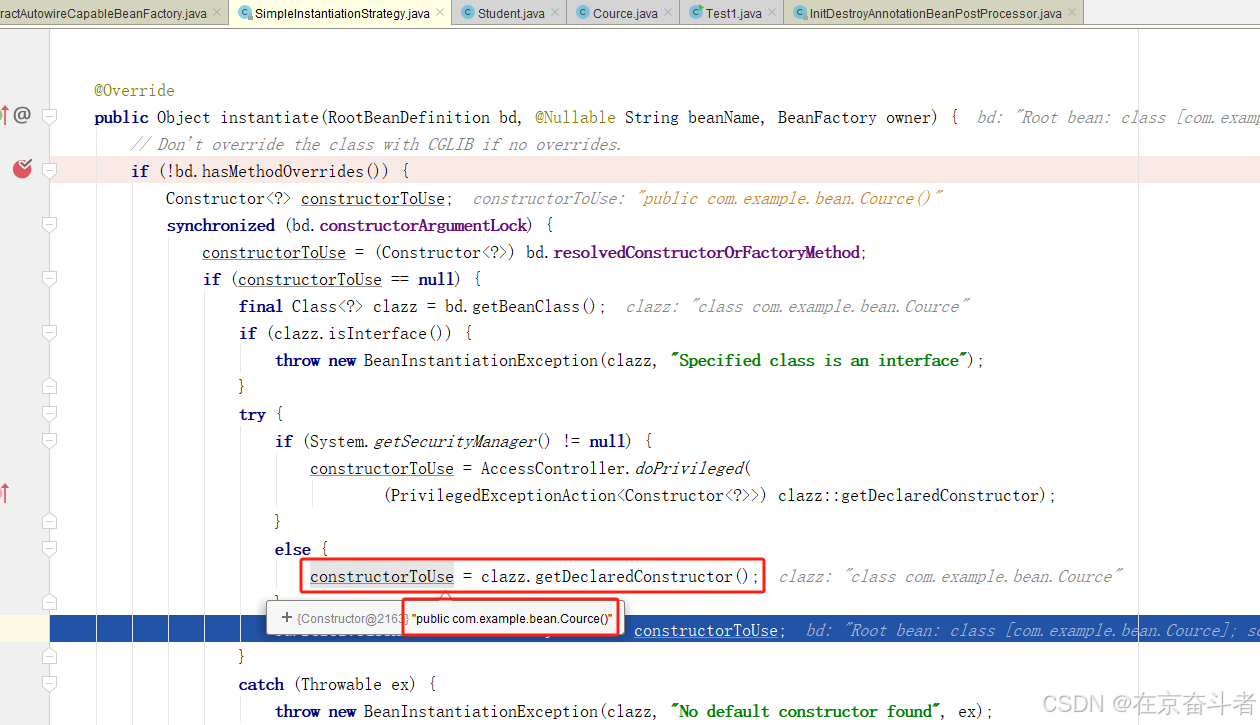
上面拿到了构造器之后,紧接着就是走到return BeanUtils.instantiateClass(constructorToUse);这行代码,从调用的方法名就知道要通过构造器去创建实例对象,源码如下所示,ReflectionUtils.makeAccessible(ctor);这行代码相信大家也不陌生,如果反射要使用私有构造器去创建实例对象的话得先进行赋权,也就是setAccessible为true。这也就是为何反射不安全的原因。紧接着我们就重点看创建实例的代码,也就是return ctor.newInstance(argsWithDefaultValues);这行代码。
java
public static < T > T instantiateClass(Constructor < T > ctor, Object...args) throws BeanInstantiationException {
Assert.notNull(ctor, "Constructor must not be null");
try {
ReflectionUtils.makeAccessible(ctor);
if (KotlinDetector.isKotlinReflectPresent() && KotlinDetector.isKotlinType(ctor.getDeclaringClass())) {
return KotlinDelegate.instantiateClass(ctor, args);
} else {
Class <? > [] parameterTypes = ctor.getParameterTypes();
Assert.isTrue(args.length <= parameterTypes.length, "Can't specify more arguments than constructor parameters");
Object[] argsWithDefaultValues = new Object[args.length];
for (int i = 0; i < args.length; i++) {
if (args[i] == null) {
Class <? > parameterType = parameterTypes[i];
argsWithDefaultValues[i] = (parameterType.isPrimitive() ? DEFAULT_TYPE_VALUES.get(parameterType) : null);
} else {
argsWithDefaultValues[i] = args[i];
}
}
return ctor.newInstance(argsWithDefaultValues);
}
} catch (InstantiationException ex) {
throw new BeanInstantiationException(ctor, "Is it an abstract class?", ex);
} catch (IllegalAccessException ex) {
throw new BeanInstantiationException(ctor, "Is the constructor accessible?", ex);
} catch (IllegalArgumentException ex) {
throw new BeanInstantiationException(ctor, "Illegal arguments for constructor", ex);
} catch (InvocationTargetException ex) {
throw new BeanInstantiationException(ctor, "Constructor threw exception", ex.getTargetException());
}
}newInstance的源码如下所示,我们显然应该关注的是倒数第二行T inst = (T) ca.newInstance(initargs);
java
@CallerSensitive
public T newInstance(Object...initargs)
throws InstantiationException, IllegalAccessException,
IllegalArgumentException, InvocationTargetException {
if (!override) {
if (!Reflection.quickCheckMemberAccess(clazz, modifiers)) {
Class <? > caller = Reflection.getCallerClass();
checkAccess(caller, clazz, null, modifiers);
}
}
if ((clazz.getModifiers() & Modifier.ENUM) != 0)
throw new IllegalArgumentException("Cannot reflectively create enum objects");
ConstructorAccessor ca = constructorAccessor; // read volatile
if (ca == null) {
ca = acquireConstructorAccessor();
}@
SuppressWarnings("unchecked")
T inst = (T) ca.newInstance(initargs);
return inst;
}创建完实例后如下图所示,可见这时Cource类只是刚实例化出来,还没有进行初始化(courceName会在afterPropertiesSet方法中被赋值),代码到这里就看完了实例化的过程。
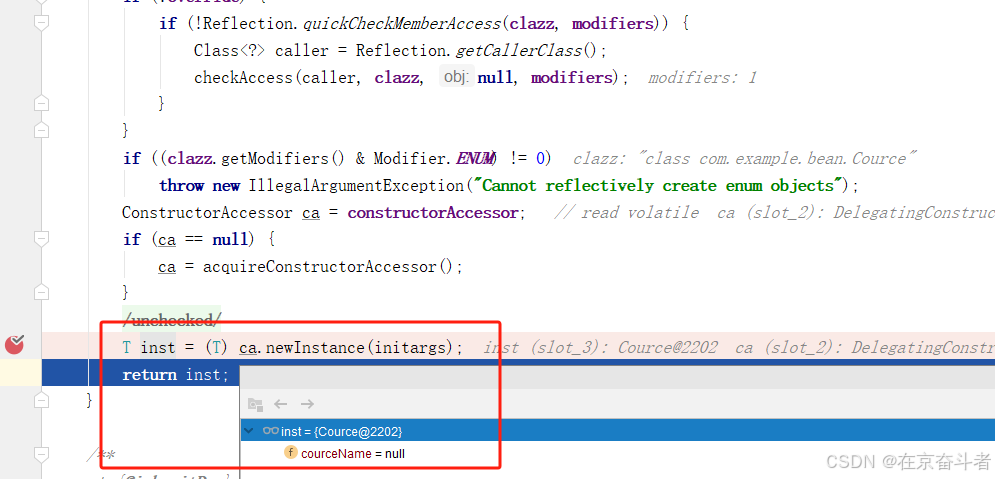
六、属性填充
我们所举例的代码中,Student类中注入了Course类,因此我们关注Student类的实例创建及属性填充。我们再回到上面提到的doCreateBean源码中,如下所示,可以看到在Object exposedObject = bean;这行代码的下面有一行populateBean(beanName, mbd, instanceWrapper);这样的代码。
java
protected Object doCreateBean(String beanName, RootBeanDefinition mbd, @Nullable Object[] args)
throws BeanCreationException {
// Instantiate the bean.
BeanWrapper instanceWrapper = null;
if (mbd.isSingleton()) {
instanceWrapper = this.factoryBeanInstanceCache.remove(beanName);
}
if (instanceWrapper == null) {
instanceWrapper = createBeanInstance(beanName, mbd, args);
}
Object bean = instanceWrapper.getWrappedInstance();
Class <? > beanType = instanceWrapper.getWrappedClass();
if (beanType != NullBean.class) {
mbd.resolvedTargetType = beanType;
}
// Allow post-processors to modify the merged bean definition.
synchronized(mbd.postProcessingLock) {
if (!mbd.postProcessed) {
try {
applyMergedBeanDefinitionPostProcessors(mbd, beanType, beanName);
} catch (Throwable ex) {
throw new BeanCreationException(mbd.getResourceDescription(), beanName,
"Post-processing of merged bean definition failed", ex);
}
mbd.postProcessed = true;
}
}
// Eagerly cache singletons to be able to resolve circular references
// even when triggered by lifecycle interfaces like BeanFactoryAware.
boolean earlySingletonExposure = (mbd.isSingleton() && this.allowCircularReferences &&
isSingletonCurrentlyInCreation(beanName));
if (earlySingletonExposure) {
if (logger.isTraceEnabled()) {
logger.trace("Eagerly caching bean '" + beanName +
"' to allow for resolving potential circular references");
}
addSingletonFactory(beanName, () - > getEarlyBeanReference(beanName, mbd, bean));
}
// Initialize the bean instance.
Object exposedObject = bean;
try {
populateBean(beanName, mbd, instanceWrapper);
exposedObject = initializeBean(beanName, exposedObject, mbd);
} catch (Throwable ex) {
if (ex instanceof BeanCreationException && beanName.equals(((BeanCreationException) ex).getBeanName())) {
throw (BeanCreationException) ex;
} else {
throw new BeanCreationException(
mbd.getResourceDescription(), beanName, "Initialization of bean failed", ex);
}
}
if (earlySingletonExposure) {
Object earlySingletonReference = getSingleton(beanName, false);
if (earlySingletonReference != null) {
if (exposedObject == bean) {
exposedObject = earlySingletonReference;
} else if (!this.allowRawInjectionDespiteWrapping && hasDependentBean(beanName)) {
String[] dependentBeans = getDependentBeans(beanName);
Set < String > actualDependentBeans = new LinkedHashSet < > (dependentBeans.length);
for (String dependentBean: dependentBeans) {
if (!removeSingletonIfCreatedForTypeCheckOnly(dependentBean)) {
actualDependentBeans.add(dependentBean);
}
}
if (!actualDependentBeans.isEmpty()) {
throw new BeanCurrentlyInCreationException(beanName,
"Bean with name '" + beanName + "' has been injected into other beans [" +
StringUtils.collectionToCommaDelimitedString(actualDependentBeans) +
"] in its raw version as part of a circular reference, but has eventually been " +
"wrapped. This means that said other beans do not use the final version of the " +
"bean. This is often the result of over-eager type matching - consider using " +
"'getBeanNamesForType' with the 'allowEagerInit' flag turned off, for example.");
}
}
}
}
// Register bean as disposable.
try {
registerDisposableBeanIfNecessary(beanName, bean, mbd);
} catch (BeanDefinitionValidationException ex) {
throw new BeanCreationException(
mbd.getResourceDescription(), beanName, "Invalid destruction signature", ex);
}
return exposedObject;
}populateBean方法源码如下,这段代码中真正执行自动注入逻辑的代码是如下图所示代码
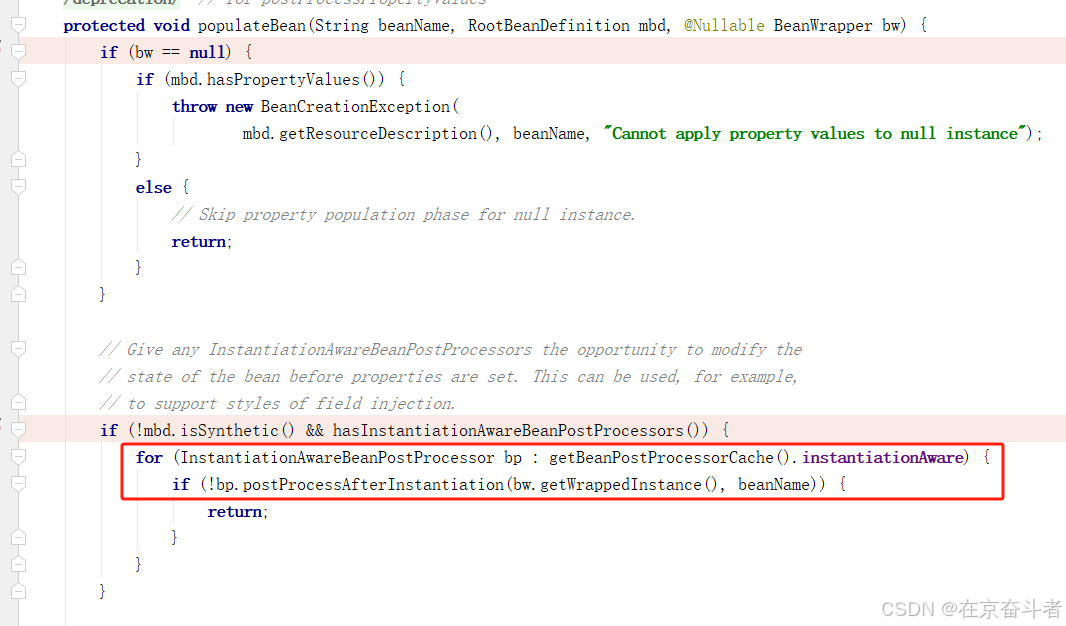
java
protected void populateBean(String beanName, RootBeanDefinition mbd, @Nullable BeanWrapper bw) {
if (bw == null) {
if (mbd.hasPropertyValues()) {
throw new BeanCreationException(
mbd.getResourceDescription(), beanName, "Cannot apply property values to null instance");
} else {
// Skip property population phase for null instance.
return;
}
}
// Give any InstantiationAwareBeanPostProcessors the opportunity to modify the
// state of the bean before properties are set. This can be used, for example,
// to support styles of field injection.
if (!mbd.isSynthetic() && hasInstantiationAwareBeanPostProcessors()) {
for (InstantiationAwareBeanPostProcessor bp: getBeanPostProcessorCache().instantiationAware) {
if (!bp.postProcessAfterInstantiation(bw.getWrappedInstance(), beanName)) {
return;
}
}
}
PropertyValues pvs = (mbd.hasPropertyValues() ? mbd.getPropertyValues() : null);
int resolvedAutowireMode = mbd.getResolvedAutowireMode();
if (resolvedAutowireMode == AUTOWIRE_BY_NAME || resolvedAutowireMode == AUTOWIRE_BY_TYPE) {
MutablePropertyValues newPvs = new MutablePropertyValues(pvs);
// Add property values based on autowire by name if applicable.
if (resolvedAutowireMode == AUTOWIRE_BY_NAME) {
autowireByName(beanName, mbd, bw, newPvs);
}
// Add property values based on autowire by type if applicable.
if (resolvedAutowireMode == AUTOWIRE_BY_TYPE) {
autowireByType(beanName, mbd, bw, newPvs);
}
pvs = newPvs;
}
boolean hasInstAwareBpps = hasInstantiationAwareBeanPostProcessors();
boolean needsDepCheck = (mbd.getDependencyCheck() != AbstractBeanDefinition.DEPENDENCY_CHECK_NONE);
PropertyDescriptor[] filteredPds = null;
if (hasInstAwareBpps) {
if (pvs == null) {
pvs = mbd.getPropertyValues();
}
for (InstantiationAwareBeanPostProcessor bp: getBeanPostProcessorCache().instantiationAware) {
PropertyValues pvsToUse = bp.postProcessProperties(pvs, bw.getWrappedInstance(), beanName);
if (pvsToUse == null) {
if (filteredPds == null) {
filteredPds = filterPropertyDescriptorsForDependencyCheck(bw, mbd.allowCaching);
}
pvsToUse = bp.postProcessPropertyValues(pvs, filteredPds, bw.getWrappedInstance(), beanName);
if (pvsToUse == null) {
return;
}
}
pvs = pvsToUse;
}
}
if (needsDepCheck) {
if (filteredPds == null) {
filteredPds = filterPropertyDescriptorsForDependencyCheck(bw, mbd.allowCaching);
}
checkDependencies(beanName, mbd, filteredPds, pvs);
}
if (pvs != null) {
applyPropertyValues(beanName, mbd, bw, pvs);
}
}真正去执行自动注入的组件是AutowiredAnnotationBeanPostProcessor,而AutowiredAnnotationBeanPostProcessor又是InstantiationAwareBeanPostProcessor的实现类,AutowiredAnnotationBeanPostProcessor类中的postProcessProperties()方法负责解析@Autowired和@Value等注解。当调用到getBeanPostProcessorCache().instantiationAware的postProcessAfterInstantiation方法时就会调用到 AutowiredAnnotationBeanPostProcessor 的 postProcessProperties() 方法,从而完成自动注入,也就是完成属性填充。如下图所示

七、Aware接口回调
我们上面看完了属性填充阶段的代码,接下来就该看初始化的方法了,不过在初始化之前会先进行Aware接口回调,我们通过代码来印证一下。
我们回到上面提到的doCreateBean源码内部,如下所示,我们找到刚才属性填充那一行代码的下一行代码,也就是populateBean方法下面的exposedObject = initializeBean(beanName, exposedObject, mbd);这行代码
java
protected Object doCreateBean(String beanName, RootBeanDefinition mbd, @Nullable Object[] args)
throws BeanCreationException {
// Instantiate the bean.
BeanWrapper instanceWrapper = null;
if (mbd.isSingleton()) {
instanceWrapper = this.factoryBeanInstanceCache.remove(beanName);
}
if (instanceWrapper == null) {
instanceWrapper = createBeanInstance(beanName, mbd, args);
}
Object bean = instanceWrapper.getWrappedInstance();
Class <? > beanType = instanceWrapper.getWrappedClass();
if (beanType != NullBean.class) {
mbd.resolvedTargetType = beanType;
}
// Allow post-processors to modify the merged bean definition.
synchronized(mbd.postProcessingLock) {
if (!mbd.postProcessed) {
try {
applyMergedBeanDefinitionPostProcessors(mbd, beanType, beanName);
} catch (Throwable ex) {
throw new BeanCreationException(mbd.getResourceDescription(), beanName,
"Post-processing of merged bean definition failed", ex);
}
mbd.postProcessed = true;
}
}
// Eagerly cache singletons to be able to resolve circular references
// even when triggered by lifecycle interfaces like BeanFactoryAware.
boolean earlySingletonExposure = (mbd.isSingleton() && this.allowCircularReferences &&
isSingletonCurrentlyInCreation(beanName));
if (earlySingletonExposure) {
if (logger.isTraceEnabled()) {
logger.trace("Eagerly caching bean '" + beanName +
"' to allow for resolving potential circular references");
}
addSingletonFactory(beanName, () - > getEarlyBeanReference(beanName, mbd, bean));
}
// Initialize the bean instance.
Object exposedObject = bean;
try {
populateBean(beanName, mbd, instanceWrapper);
exposedObject = initializeBean(beanName, exposedObject, mbd);
} catch (Throwable ex) {
if (ex instanceof BeanCreationException && beanName.equals(((BeanCreationException) ex).getBeanName())) {
throw (BeanCreationException) ex;
} else {
throw new BeanCreationException(
mbd.getResourceDescription(), beanName, "Initialization of bean failed", ex);
}
}
if (earlySingletonExposure) {
Object earlySingletonReference = getSingleton(beanName, false);
if (earlySingletonReference != null) {
if (exposedObject == bean) {
exposedObject = earlySingletonReference;
} else if (!this.allowRawInjectionDespiteWrapping && hasDependentBean(beanName)) {
String[] dependentBeans = getDependentBeans(beanName);
Set < String > actualDependentBeans = new LinkedHashSet < > (dependentBeans.length);
for (String dependentBean: dependentBeans) {
if (!removeSingletonIfCreatedForTypeCheckOnly(dependentBean)) {
actualDependentBeans.add(dependentBean);
}
}
if (!actualDependentBeans.isEmpty()) {
throw new BeanCurrentlyInCreationException(beanName,
"Bean with name '" + beanName + "' has been injected into other beans [" +
StringUtils.collectionToCommaDelimitedString(actualDependentBeans) +
"] in its raw version as part of a circular reference, but has eventually been " +
"wrapped. This means that said other beans do not use the final version of the " +
"bean. This is often the result of over-eager type matching - consider using " +
"'getBeanNamesForType' with the 'allowEagerInit' flag turned off, for example.");
}
}
}
}
// Register bean as disposable.
try {
registerDisposableBeanIfNecessary(beanName, bean, mbd);
} catch (BeanDefinitionValidationException ex) {
throw new BeanCreationException(
mbd.getResourceDescription(), beanName, "Invalid destruction signature", ex);
}
return exposedObject;
}我们进入到方法initializeBean内部,如下所示,我们在第一个else分支中可以看到invokeAwareMethods(beanName, bean);这么一行代码,从字面意思就可以看出来这是要执行Aware接口回调了。
java
protected Object initializeBean(String beanName, Object bean, @Nullable RootBeanDefinition mbd) {
if (System.getSecurityManager() != null) {
AccessController.doPrivileged((PrivilegedAction < Object > )() - > {
invokeAwareMethods(beanName, bean);
return null;
}, getAccessControlContext());
} else {
invokeAwareMethods(beanName, bean);
}
Object wrappedBean = bean;
if (mbd == null || !mbd.isSynthetic()) {
wrappedBean = applyBeanPostProcessorsBeforeInitialization(wrappedBean, beanName);
}
try {
invokeInitMethods(beanName, wrappedBean, mbd);
} catch (Throwable ex) {
throw new BeanCreationException(
(mbd != null ? mbd.getResourceDescription() : null),
beanName, "Invocation of init method failed", ex);
}
if (mbd == null || !mbd.isSynthetic()) {
wrappedBean = applyBeanPostProcessorsAfterInitialization(wrappedBean, beanName);
}
return wrappedBean;
}我们debug代码走到Student类的初始化流程,看看代码执行到invokeAwareMethods方法内部时,我们可以看到代码会走setBeanName方法,而我们的Student类中因为实现了BeanNameAware接口,因此重写了setBeanName方法,因此代码走到这里就该去Student类中执行setBeanName方法了。
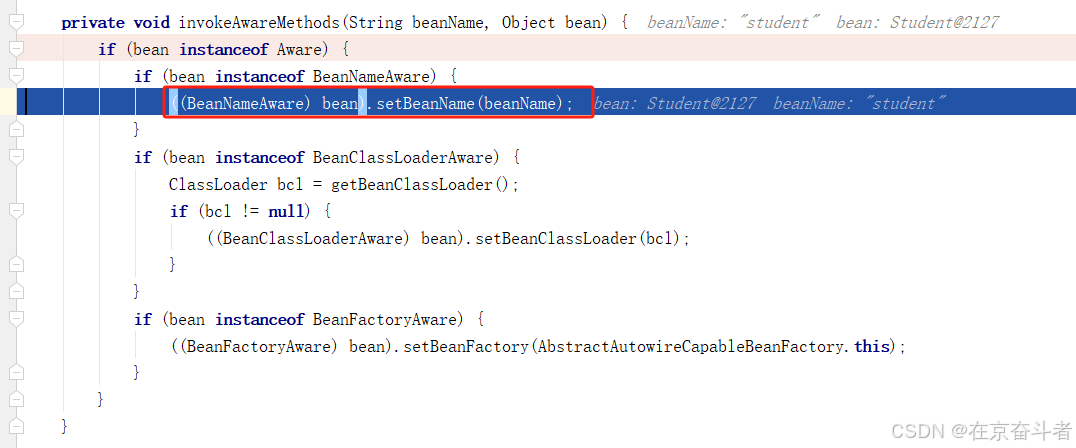
我们debug结果如下图所示,可以看到,确实是进入到Student类的setBeanName方法中去执行了。这就是Aware接口回调的简单应用。
 八、初始化前处理器(BeanPostProcessor前置处理)
八、初始化前处理器(BeanPostProcessor前置处理)
我们目前代码走到这里,Student类还没有完成初始化呢,而在初始化方法被调用之前,还有个步骤就是初始化前置处理器,我们从源码来看,我们先回到initializeBean方法源码,如下所示,这里面有一行代码是wrappedBean = applyBeanPostProcessorsBeforeInitialization(wrappedBean, beanName);这就是执行初始化前置处理器,我们这里没有举初始化前置处理所用到的例子(涉及到初始化前置处理器的场景包括我们的类中使用了@PostConstruct注解修饰一个初始化方法,这种场景下,执行@PostConstruct这个注解修饰的方法就发生在初始化前置处理器之中)
java
protected Object initializeBean(String beanName, Object bean, @Nullable RootBeanDefinition mbd) {
if (System.getSecurityManager() != null) {
AccessController.doPrivileged((PrivilegedAction < Object > )() - > {
invokeAwareMethods(beanName, bean);
return null;
}, getAccessControlContext());
} else {
invokeAwareMethods(beanName, bean);
}
Object wrappedBean = bean;
if (mbd == null || !mbd.isSynthetic()) {
wrappedBean = applyBeanPostProcessorsBeforeInitialization(wrappedBean, beanName);
}
try {
invokeInitMethods(beanName, wrappedBean, mbd);
} catch (Throwable ex) {
throw new BeanCreationException(
(mbd != null ? mbd.getResourceDescription() : null),
beanName, "Invocation of init method failed", ex);
}
if (mbd == null || !mbd.isSynthetic()) {
wrappedBean = applyBeanPostProcessorsAfterInitialization(wrappedBean, beanName);
}
return wrappedBean;
}九、初始化
在看完初始化前置处理器之后,我们紧接着就是看初始化的源码,我们还是回到initializeBean方法内部,如下所示,中间try中的那行invokeInitMethods(beanName, wrappedBean, mbd);代码就是执行初始化逻辑。
java
protected Object initializeBean(String beanName, Object bean, @Nullable RootBeanDefinition mbd) {
if (System.getSecurityManager() != null) {
AccessController.doPrivileged((PrivilegedAction < Object > )() - > {
invokeAwareMethods(beanName, bean);
return null;
}, getAccessControlContext());
} else {
invokeAwareMethods(beanName, bean);
}
Object wrappedBean = bean;
if (mbd == null || !mbd.isSynthetic()) {
wrappedBean = applyBeanPostProcessorsBeforeInitialization(wrappedBean, beanName);
}
try {
invokeInitMethods(beanName, wrappedBean, mbd);
} catch (Throwable ex) {
throw new BeanCreationException(
(mbd != null ? mbd.getResourceDescription() : null),
beanName, "Invocation of init method failed", ex);
}
if (mbd == null || !mbd.isSynthetic()) {
wrappedBean = applyBeanPostProcessorsAfterInitialization(wrappedBean, beanName);
}
return wrappedBean;
}我们为验证这个,还是通过debug的方式来进行,我们进入到invokeInitMethods源码内部,在代码中间else分支中有一行((InitializingBean) bean).afterPropertiesSet();便是执行Student类中的afterPropertiesSet方法。
java
protected void invokeInitMethods(String beanName, Object bean, @Nullable RootBeanDefinition mbd)
throws Throwable {
boolean isInitializingBean = (bean instanceof InitializingBean);
if (isInitializingBean && (mbd == null || !mbd.isExternallyManagedInitMethod("afterPropertiesSet"))) {
if (logger.isTraceEnabled()) {
logger.trace("Invoking afterPropertiesSet() on bean with name '" + beanName + "'");
}
if (System.getSecurityManager() != null) {
try {
AccessController.doPrivileged((PrivilegedExceptionAction < Object > )() - > {
((InitializingBean) bean).afterPropertiesSet();
return null;
}, getAccessControlContext());
} catch (PrivilegedActionException pae) {
throw pae.getException();
}
} else {
((InitializingBean) bean).afterPropertiesSet();
}
}
if (mbd != null && bean.getClass() != NullBean.class) {
String initMethodName = mbd.getInitMethodName();
if (StringUtils.hasLength(initMethodName) &&
!(isInitializingBean && "afterPropertiesSet".equals(initMethodName)) &&
!mbd.isExternallyManagedInitMethod(initMethodName)) {
invokeCustomInitMethod(beanName, bean, mbd);
}
}
}代码执行效果如下图所示,可以看到确实进入到afterPropertiesSet方法内部了。从而这里就完成了初始化的动作。

十、初始化后置处理器
我们demo中没有涉及到初始化后置处理器的场景,但其实我们最常见的AOP,就可能发生在这个阶段。初始化后置处理器的源码我们还是回到上面提到的initializeBean方法源码内部,如下所示,在差不多最下面有一行wrappedBean = applyBeanPostProcessorsAfterInitialization(wrappedBean, beanName);代码,就是处理初始化后置处理器的。
java
protected Object initializeBean(String beanName, Object bean, @Nullable RootBeanDefinition mbd) {
if (System.getSecurityManager() != null) {
AccessController.doPrivileged((PrivilegedAction < Object > )() - > {
invokeAwareMethods(beanName, bean);
return null;
}, getAccessControlContext());
} else {
invokeAwareMethods(beanName, bean);
}
Object wrappedBean = bean;
if (mbd == null || !mbd.isSynthetic()) {
wrappedBean = applyBeanPostProcessorsBeforeInitialization(wrappedBean, beanName);
}
try {
invokeInitMethods(beanName, wrappedBean, mbd);
} catch (Throwable ex) {
throw new BeanCreationException(
(mbd != null ? mbd.getResourceDescription() : null),
beanName, "Invocation of init method failed", ex);
}
if (mbd == null || !mbd.isSynthetic()) {
wrappedBean = applyBeanPostProcessorsAfterInitialization(wrappedBean, beanName);
}
return wrappedBean;
}经过以上步骤之后,我们的Bean就初始化完成了,也就准备就绪了。我这里只是举了一个比较简单的场景,更多复杂的场景大家可以自行研究学习。